How to Plan an Incredible Oregon Road Trip (14 Days)
Looking to plan an amazing Oregon Road Trip? You’re in the right place. We live in Portland, and spend a big chunk of our summers on the road exploring our adopted home state of Oregon. We’re here to use our experiences around Oregon to help you plan your own amazing Oregon adventure.
We’re going to go over a perfect road trip itinerary that takes you to many of our favorite places in Oregon over 14 days, which is based on our own experiences exploring the state.
Have more or less time than that? Have no fear, we’ve got ideas on how to structure a trip with more and less time below the main itinerary, and you can use the details in the main itinerary to help you plan out your trip.
We were lucky enough to spend two whole months on a road trip around Oregon a few summers ago after we had to scrap our international travel plans, and it taught us an important lesson: you don’t need to fly halfway around the world to find wild and beautiful places – sometimes they’re right in your backyard the whole time.
It also cemented our belief that Oregon was the place we wanted to put down roots and create a home base after years of living on the road.
Fast forward a couple of years, and we decided to make our forever home in Portland, Oregon, and that initial time exploring Oregon was a huge part of why we ultimately ended up making that decision.
Oregon has it all – the coast, the mountains, the desert, a truly unbelievable number of amazing waterfalls, and more.
In this complete guide to planning your Oregon road trip itinerary, we’re going to give you the logistics you need to know – when to visit and our recommended route – along with a mini guide to each place on the itinerary.
That mini guide will have information like what to do and where to stay – all based on our own experiences exploring Oregon – along with links to more in-depth content we’ve written on the destination.
In each “where to stay” section, we’ll give you options for camping (which is what we usually do) and not camping, which we recognize is what the vast majority of people prefer.
Finally, at the end, we’ll give you some ideas on how to shorten or lengthen the itinerary to fit your particular trip.
Sound good to you? This guide is super detailed, full of our tips and favorite places based on our extensive experience exploring Oregon, which means it’s LONG. Strap yourself in, grab a cup of coffee (or beer or wine, no judgment here), and let’s get to exploring Oregon!
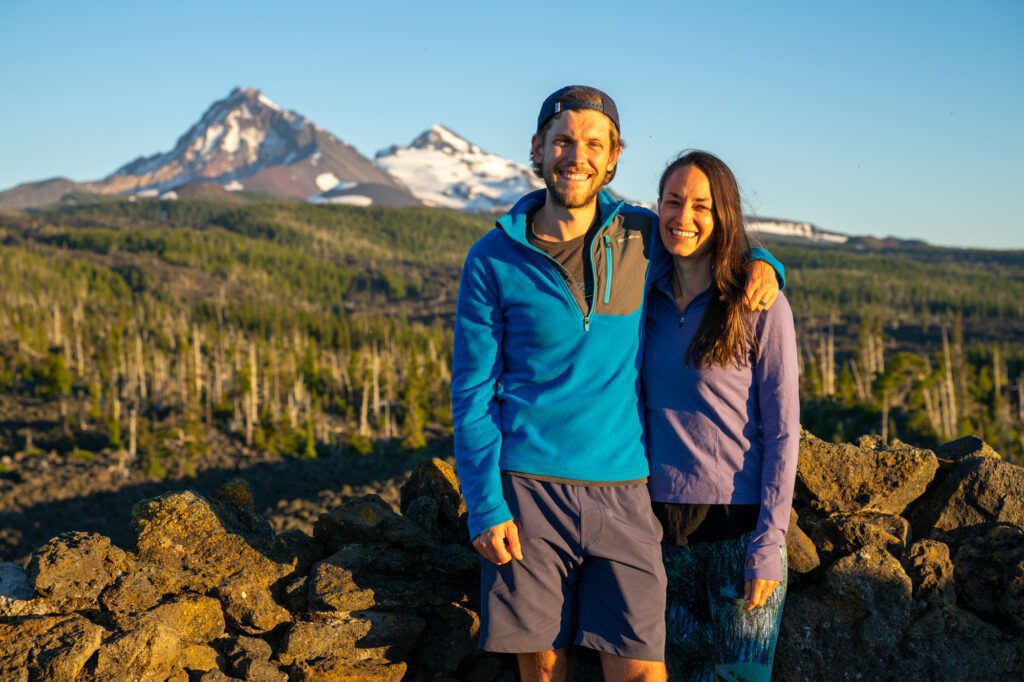

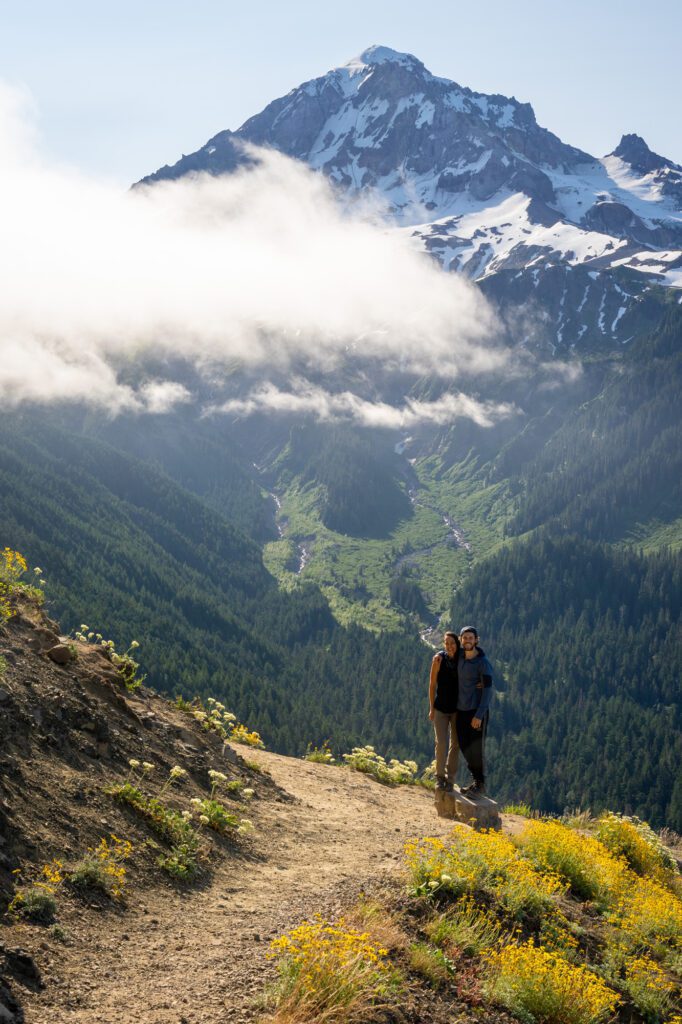
Disclaimer: Some of the links in this post, like hotel and vacation rental links, are affiliate links, meaning at no additional cost to you we make a little bit of money if you click through and book. That being said, we would absolutely never recommend something to you that we don’t stand behind 100%.
Disclaimer: Some of the links in this post, like hotel and vacation rental links, are affiliate links, meaning at no additional cost to you we make a little bit of money if you click through and book. That being said, we would absolutely never recommend something to you that we don’t stand behind 100%.
A Quick (and Oversimplified) Oregon Geography Lesson
Before we get into the road trip itinerary, let’s quickly talk about Oregon’s geography, and what it means for your trip.
First of all, Oregon is a lot bigger than you probably think. It’s the 9th largest state in the country by square mileage, which is a fact that blew my mind. Driving between places can take several hours, if not more.
Why do we bring this up? Because it has one major implication for your trip.
Unless you want to spend full days of your trip driving without stopping to see the scenery, you’re not going to be able to see the entire state.
Fear not – we have a strong perspective on where you should focus your time if it’s your first trip to Oregon. Which means we need to talk about Oregon’s geography.
Oregon is a very diverse state when it comes to landscapes, which is part of why we love it. It’s home to rocky coastline, wide sandy beaches, rolling hills and lush valleys, moist rainforests, towering snowy peaks, and even the high desert.
When you think about Oregon’s geography, we’d cut the state roughly into quadrants, with Eugene as the center point in the state.
If it’s your first time in Oregon, you’re going to want to focus on the northwest quadrant, almost exclusively. The exception might be Crater Lake National Park, which we have a whole section on below to help you figure out where to fit it in.
If you start to try fitting in places all over the state, you’re going to spend entire days driving long distances, which we don’t really think is the best experience. For reference, it takes three and a half hours to go from Newport on the Oregon Coast over to Bend (without traffic). Then, it’s another two hours to the Painted Hills from Bend. And a full four hours back to Portland from there.
In this itinerary, Bend is the furthest east you’ll go. It’s just not feasible to get to every corner of the state, especially with limited time.
If you happen to have an extra week (lucky you!), that’s when we’d add the Painted Hills and Wallowa Mountains, and some of the other spots in eastern Oregon. Or the southern Oregon coast, which is much more rugged and wild than the northern coast that you’ll cover in this itinerary.
How Many Days Do You Need for this Road Trip?
We really, really think that to do a full road trip around Oregon that includes both the northern coast and Bend, you need a full two weeks (14 days). Otherwise, you’ll spend way too much time driving, and not enough time out exploring.
Which is exactly how we’ve written the road trip below.
If you have 7-10 days, we’d do a more focused road trip that follows a figure-8 with Portland at the center. Head east to the Columbia River Gorge, Hood River, and Mount Hood, then come back through Portland and head out to the Oregon Coast for a few nights, focusing on the stretch from Astoria to Tillamook. Here’s a map.
If you do have less time, we have example itineraries for 7 and 10 day road trips below the main itinerary to help you organize your time.
The Best Time to Plan a Road Trip in Oregon
This is a very, very important section in this guide, which is why it’s the first thing we’re talking about.
If you are interested in hiking in the Cascades – specifically near Mount Hood or Bend – your trip will need to be sometime between July and mid-October.
Otherwise, high elevation hiking trails will be covered in snow, and some roads and sections of the parks will be closed.
The exact timing depends on the year, precipitation, and spring temperatures (among other factors), but you will be most safe with a trip in August or September.
The best time to plan this road trip is going to be July, August, and September. That’s when roads are open, trails are largely snow-free, and you’ll be able to see everything you want to see.
During the summer and early fall, mountain passes and hiking trails are clear of snow, days are warm and sunny, the sun rises before 6:00 am and sets after 9:30 pm, and it’s an all around spectacular time to be in Oregon.
The downside is that, in recent years, Oregon has been ravaged by forest fires during the summer, bringing a thick smoke that makes it really unhealthy and unpleasant to be outside. It’s hard to predict, but it’s something to be aware of if you’re planning a trip in the summer.
Early fall is another great time to visit Oregon. The weather is, for the most part, still great (though it’s a little more unpredictable than summer).
As you get into October, things start to cool off and snow can begin to show up in some of the passes through the Cascades (the McKenzie River Scenic Byway, for example), which can make travel a bit more difficult.
Spring is gray and wet, though late spring (think Memorial Day into June) is a cool time to visit Oregon because of the blooming rhododendrons and roses. The weather isn’t going to be the best, but you’ll probably get a few nice, clear days over the course of your trip.
In the spring, hiking trails at elevation – like around Mount Hood and Bend – are still going to be closed. If you’re into hiking, we’d definitely recommend waiting until later in the summer.
Winter isn’t a great time to do this road trip, if we’re being totally honest. The Cascades are blanketed in snow, which means you won’t get much of a taste of the mountains in Oregon (though you can get some skiing in at Mount Bachelor!) and the mountain passes are harder to navigate, often closing for days at a time due to winter storms.
The upside of visiting in the winter is that the waterfalls in Oregon are WILD when it’s raining.
If you’re visiting in the winter, we’d stick to the areas west of the mountains and do the Columbia River Gorge, Hood River, Silver Falls State Park, and the Oregon Coast. For what it’s worth, we’ve done the Oregon Coast multiple times in the winter, and it’s very moody (and wet).
Here’s a map of what a winter road trip in Oregon might look like.
Where to Start and End Your Road Trip
This one is easy – Portland!
Portland is not really central in terms of the state – it’s up in the northwest corner – but it is central to some of Oregon’s best sights (the coast, Mount Hood, the Columbia River Gorge, etc etc) AND it’s the best airport in the state (dare we say country?).
Unless you live somewhere in Oregon or you’re driving up from California, the answer is Portland.
The exception is if you have 10 days in Oregon and follow our road trip itinerary below. In that scenario, we’d recommend flying into Portland, and out of Bend (Redmond Municipal Airport, RDM) to save time on driving back to Portland just to catch a flight.
Flights out of Bend will be more expensive and involve connecting through Portland or Seattle, but it’ll save you four hours of driving.
Where to Fly in and Out of?
The best option, with the most flights coming in and going out, is going to be our home airport – Portland International Airport (PDX).
Having lived in both Seattle and San Francisco, PDX is amazing when you compare it to those airports.
It’s relatively well organized (as well organized as an airport can really be), and it’s clean, has good local food and drink options, and the security lines are never “oh no am I going to miss my flight?” long.
There are a couple of smaller airports in Oregon that could work, but will likely be more expensive and have fewer flight options. Those would be places like Eugene (EUG) and Bend / Redmond (RDM).
Chances are, PDX is going to be the best choice for about 99% of people. Plus, there are more rental car options!
Do You Need to Rent a Car?
It probably goes without saying that you will need a car to do this road trip. If you’re coming from out of state, that probably means renting a car when you arrive.
One thing we’d recommend is that you avoid having your rental car when you’re in the city of Portland.
We’ve organized the itinerary below to have Portland at the end, and we’d strongly recommend that you drop your car off at the airport when you roll into Portland, and spend your day or two in town carless.
Another cool option would be renting a campervan for this road trip! On our six week road trip around Oregon in 2020 – the one that made us fall in love with the state and eventually move here – we lived out of our converted Honda Odyssey.
We love the flexibility of van living, though it certainly isn’t nearly as sexy as it looks in all of those pictures on Instagram.
We have a few favorite campgrounds in Oregon that we’ll give you in the itinerary below that are a once-in-a-lifetime experience (looking at you, Trillium).
One thing we’ve been DYING to do is rent an Escape Campervan. If you’re looking to experience the whole camping thing, but don’t want to sleep in a tent (to be clear, we’re all for tent camping), then a campervan might be for you!
Escape’s vans are all hand-painted, have full kitchens, and would be a lovely way to experience Oregon.
Escape has an office in Portland, which is where you’d pick up and drop off your van.
The Route for This Road Trip
With that in mind, here’s a summary of the 14 day road trip we’ll cover in detail below.
- Day 1: Astoria
- Day 2: Cannon Beach
- Days 3-4: Tillamook & the Three Capes Scenic Route
- Day 5: Newport, Cape Perpetua, & Heceta Head Lighthouse
- Day 6: Drive the McKenzie River Scenic Byway to Bend
- Days 7-8: Bend (and the Cascade Lakes Scenic Byway)
- Day 9: Smith Rock State Park
- Days 10-11: Mount Hood (Government Camp)
- Days 12-13: Hood River and the Columbia River Gorge
- Day 14: Explore Portland
Here’s a map of that route.
We think this itinerary is a good blend of scenic drives (the Oregon Coast and the McKenzie River Scenic Byway are two of our favorites), cool towns (Astoria, Hood River, and Bend), and great outdoor adventures.
Which is basically everything we love about Oregon, packed into two weeks (minus some of the further out spots that don’t make sense here).
Like we said, you can’t fit it all into one road trip. But we’ve done our best to include the highlights in hopes that you’ll fall in love with Oregon and come back a second (and third) time to explore more.
Of course, that’s just the base itinerary that we’d recommend. The exact route you take is going to depend on your particular interests, what time of year you’re visiting, and more factors than we can possibly take into account here.
We have ideas for shorter and longer itineraries below the main itinerary if you have more or less time.
We’ll do our best to give you all the information you need to plan YOUR road trip in Oregon, but if we miss something or you have more questions, leave us a comment below and we’ll do our best to either answer your question, or point you to someone who can.
Exactly How to Plan an Amazing Oregon Road Trip Itinerary
Now that we’ve covered the logistics you need to know to really plan your trip, let’s get into the itinerary itself!
There are a couple of principles that we’re going to follow as we take you through our perfect version of a road trip in Oregon.
- We think you should see the mountains and the coast. Both are spectacular, and part of the reason we love Oregon is that you can go from the mountains to the coast in about two hours, give or take. It’s magical.
- Oregon is big, and you don’t want to spend the entire time driving. We’re going to try and make sure you’re only driving a maximum of four hours between destinations, which means more time exploring, less time driving.
- There are too many places to see in one trip. Instead of trying to fit every single place into one road trip, we think you should focus so that you aren’t just rolling into a place in the late afternoon, and leaving the next morning. This, of course, means that you’re probably not going to be able to fit every single place into your itinerary. And that’s okay! You can always come back. In this itinerary, we’re focusing on the western half of the state, which is NOT to say there aren’t amazing things to see east of the Cascades.
With those principles in mind, we’ve created this 14 day Oregon itinerary so that you can almost literally copy and paste it for your trip if that’s what you want.
Or, you can use bits and pieces of it to cobble together your own version of the road trip. Whatever works best for you!
Day 1: Astoria
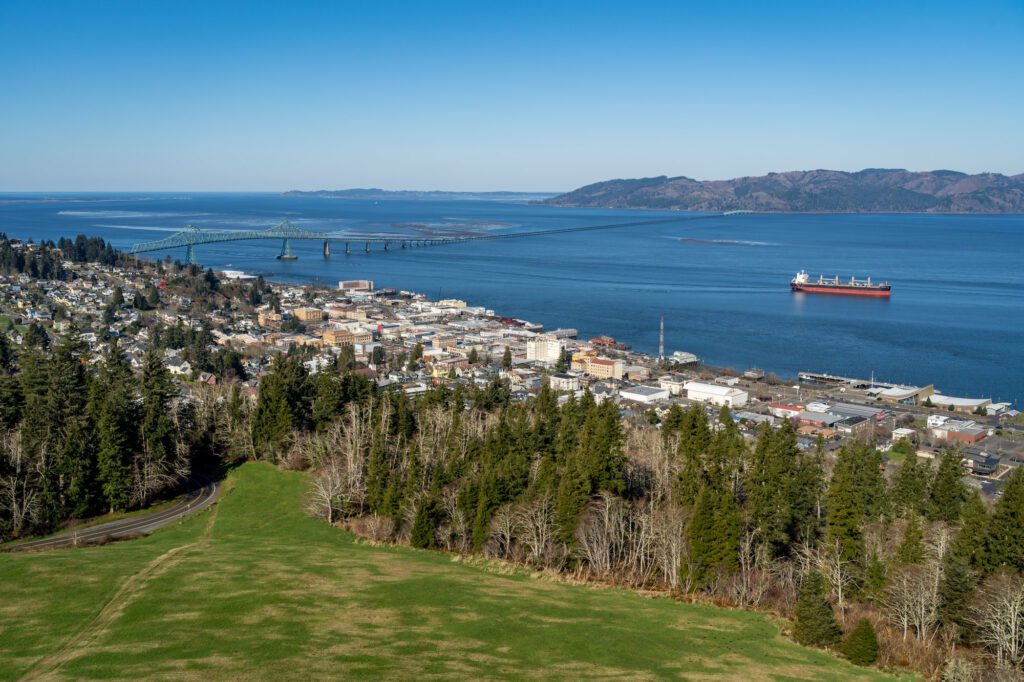
Drive Time / Distance from Portland International Airport to Astoria: 2 hours / 95 miles
Where to Stay in Astoria: You want to stay centrally so you can walk to the attractions downtown. We stayed at Norblad on our last trip, and liked it (nice location, stylish rooms, comfy beds).
Astoria is a fitting first stop on this itinerary, because in many ways, it’s where the state of Oregon as we know it today began. Lewis and Clark Historical Park, which is just south of the city center, is near the location where Lewis and Clark made camp for three months, having completed their mission to find the Pacific Ocean.
Now, you might be thinking that Lewis and Clark, who had completed their ultimate goal after a significant chunk of time spent struggling west from St. Louis, might have been celebrating with their feet up.
But their arrival and stay happened to be smack dab in the middle of winter – from December through February – so rather than celebrating with the long, warm days of an Oregon summer, they were treated to constant drizzle and less than eight hours of sunlight. FUN.
Anyway, Astoria is meaningful in many ways, from the early 19th Century and Lewis and Clark’s antics, to the time when John Jacob Astor tried to make Astoria the New York City of the west (he almost had it!).
Today, it sits at the northwestern corner of Oregon, and is home to what has to be the highest number of breweries per capita in the country (there’s four or five, and Astoria is tiny), and filming locations for some of the iconic films of the 90’s (the Goonies and Kindergarten Cop, among others).
What to Do in Astoria
Here are some of our favorite things to do in Astoria.
Lewis and Clark National Historical Park: Like we mentioned, Lewis and Clark National Historical Park is near the site of Fort Clatsop, which is where they set up camp for three miserable months before heading home to report back to Jefferson. There’s a model of Fort Clatsop here, a bunch of fun information on what life was like on that expedition (and some very charismatic rangers eager to share anecdotes like the one above), and a hike that connects the fort with the coast, a route that they covered many times. However, the hike isn’t really worth too much of your time – it’s 6.5 miles one way out to the coast – we’d do the first mile or so, enjoying the ferny forests of sitka spruce trees before heading back.
The Astoria Column: The Astoria Column is perched up on the hill above town with a commanding view out over the Columbia River and the famous Astoria-Megler Bridge – that’s the green bridge crossing the river to the Washington side. The Column is an interesting piece of art, because it is wrapped in the story of Astoria. It’s hard to see the artwork when you’re standing at the base looking up at it, but there’s a digital re-creation with labels that is helpful to understand exactly what you’re viewing. You can climb to the top of the column for an even more impressive view of the river. It costs $5 to park in the lot at the Column, or you can park at the base of the hill in town (roughly here) and hike the Cathedral Tree Trail up for free.
Fort Stevens State Park: This is the northwest corner of Oregon, and also – fun fact – the site of the only attack on a military base in the contiguous United States since the War of 1812 (the Japanese shelled it a few times in 1942). It’s a State Park, though it was a military base through the early 20th Century. Today, the bunkers are one of the main draws here, and are particularly interesting when there are rangers and volunteers out there to tell you stories about the local history (which is usually on weekends in the summer). It’s worth driving out to the coast and hitting the wreck of the Peter Iredale, a shipwreck on a wide sandy beach, and Clatsop Spit at Lot C (here on Google Maps) where you can walk out along the rocks on the Pacific.
The Breweries: Two of Oregon’s best breweries are up in Astoria – Buoy Beer Co and Fort George Brewing – and are basically a must-stop for any beer aficionados who find themselves in the state’s northwest corner. They each have a taproom within walking distance of the main drag, and both have food menus and extensive taplists, with many beers you’re not going to find outside of the taproom. In addition, there are a few smaller breweries (like Fortune and Glory Cider Company – technically not a brewery, I guess). Across the street from them is Bridge & Tunnel Bottleshop & Taproom, the best beer bar in Astoria (and a good place to try multiple beers from different breweries).
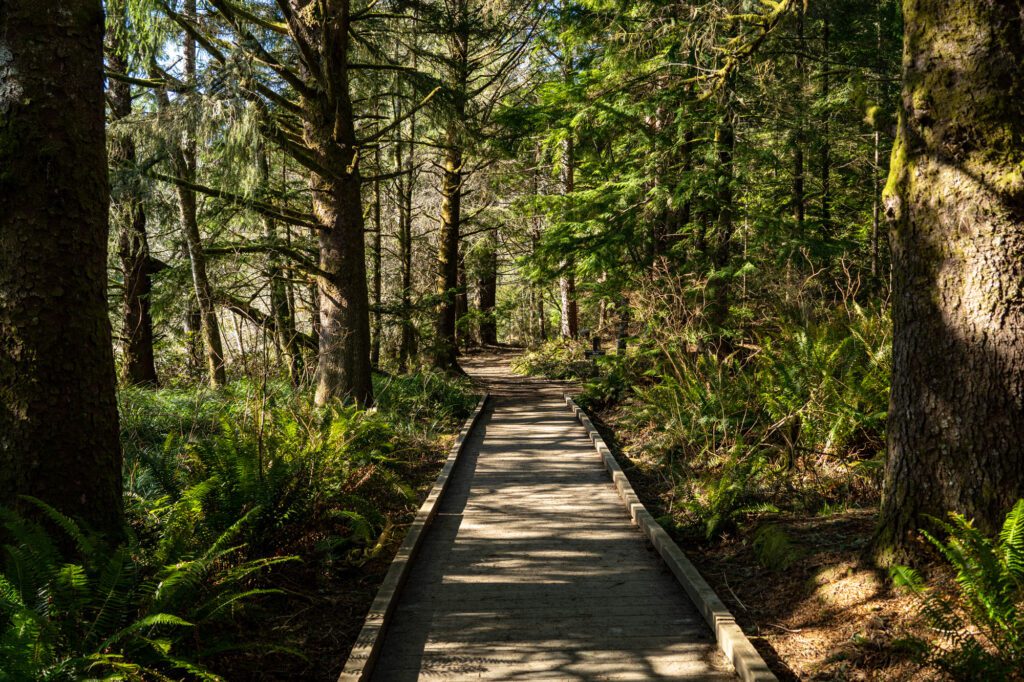
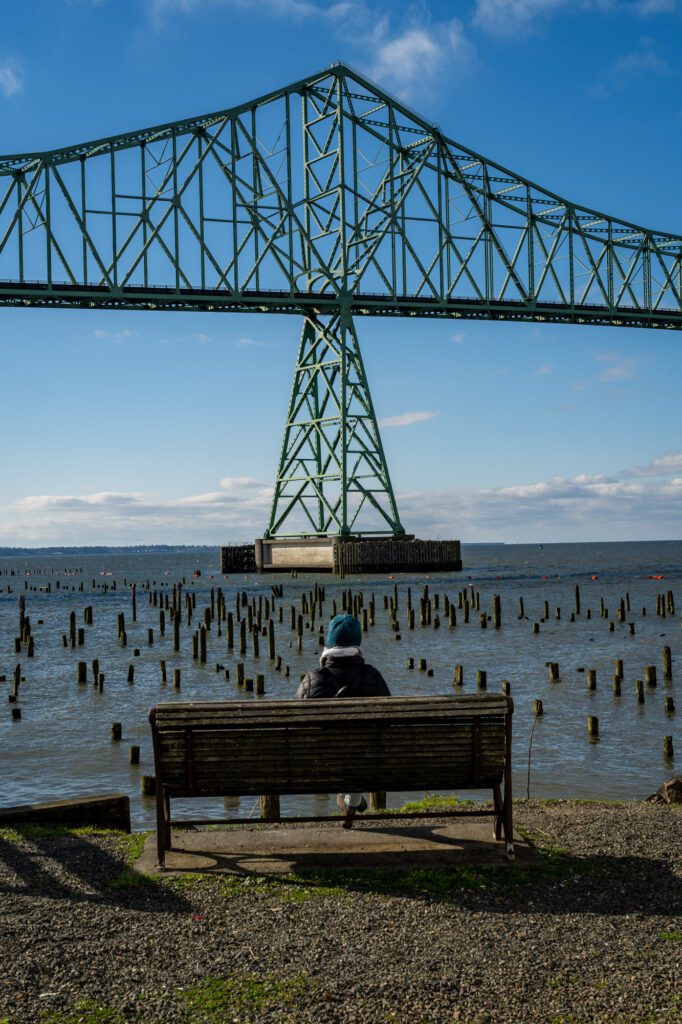
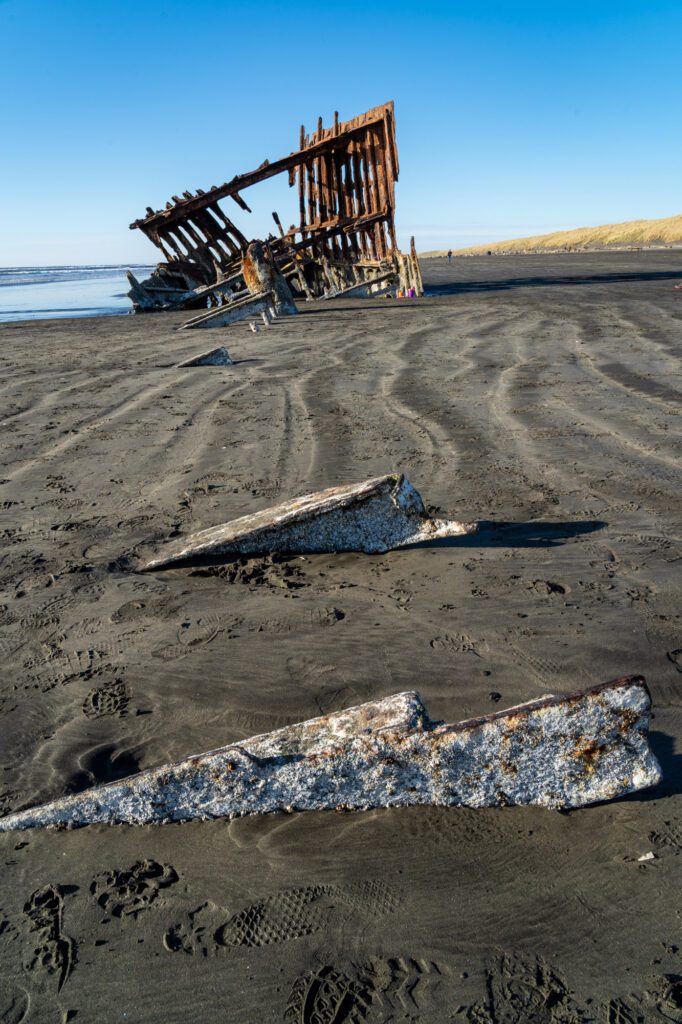
Day 2: Cannon Beach
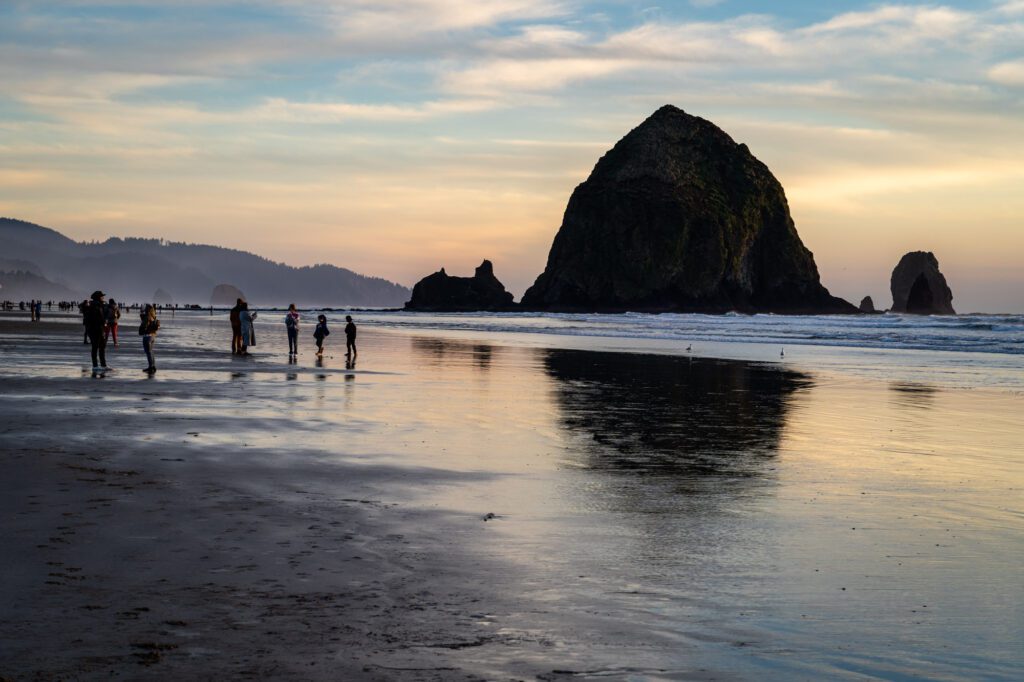
Drive Time / Distance from Astoria to Cannon Beach: 40 minutes / 25 miles
Where to Stay in Cannon Beach: For Cannon Beach, you have two choices – on the beach (more expensive, nice experience) or a few blocks away from the beach (cheaper, less romantic). We’ve stayed at the Inn at Haystack Rock twice, which falls in the latter category and is nice enough (but probably needs a bit of a facelift in the next couple of years).
Cannon Beach is one of the most popular day trips from Portland, because it’s a mere 90 minutes from downtown Portland. As a result, the area can feel unbearably overcrowded on summer weekends, as Portlanders (us included) flock to the coast to escape the inland heat.
However, on a weekday or early in the morning and later in the evening, Cannon Beach is a lovely place to spend some time.
We recently went out to Cannon Beach – our first beach foray with our dog, Lupine – midweek in January, and we were basically the only people on the hiking trail in Ecola State Park. It was wet and muddy, yes, but it was so peaceful.
The highlights in Cannon Beach are actually the state parks that border the town on the north and south end, Ecola State Park and Oswald West State Park.
Sure, Cannon Beach – the town AND the beach – is nice, and you should definitely do a sunset walk on the beach. But definitely don’t miss the nearby state parks.
What to Do in Cannon Beach
Here are some Cannon Beach highlights that you really shouldn’t miss.
Haystack Rock: It’s cliche, but Haystack Rock really is an impressive sight, especially if you’re not used to the towering sea stacks that you find up and down the Oregon and Washington coast. In fact, we’d argue that Haystack Rock is up near the top of the list of tourist attractions in Oregon, somewhere below Multnomah Falls and above Powell’s Books in Portland. It’s a huge sea stack, rising 235 feet out of the surf to tower over the beach and surrounding community. It’s particularly spectacular at low tide, when you get some cool reflections in the wet sand. On our first trip to Cannon Beach, we witnessed a pair of Bald Eagles raiding the resident puffin colony for their eggs! It was quite the drama, and there are rangers on the beach in the summer who talk about the puffins and the attempts to keep them alive.
Ecola State Park: Ecola State Park was closed for years and years until very recently, when it was reopened to the public. As you drive in on the windy, tree-lined road, it’s easy to see why a couple of bad storms put the park out of commission for a couple of years. This park is one of the most popular destinations on the Oregon Coast, so it’s likely to be busy if you’re here in the summer or on a weekend. Get there early to get a parking spot in the relatively small lots! There are two things not to miss in Ecola State Park, we think.
- The first is Crescent Beach, which is a short hike accessed either from the main parking lot, or by walking into the park from Cannon Beach. From the main lot, which you should visit whether you do the hike or not for the views, it’s a short downhill hike that winds through the ferny forest before an aggressive descent down to the beach. The beach is best at low tide, when it’s wide and sandy and littered with driftwood and sea stacks. Basically, everything you could possibly want in a Pacific Northwest beach.
- The second is Indian Beach. There’s a parking lot right at Indian Beach that fills up early because it’s a popular surfing destination. You can also hike out to Indian Beach from the main parking lot in the park, which is worth doing for the coastal views along the way.
Hiking in Oswald West State Park: This is the other Oregon state park we referenced above, and it’s equally worthwhile. There are three hikes here to focus your time on. First is the hike to the top of Neahkahnie Mountain, which is an aggressive ascent up switchbacks to a viewpoint where you can see miles and miles of coastline to the south. Second is the hike out to Cape Falcon, which navigates out to the cape on the north side of Short Sand Beach, where you’ll have excellent views back towards the beach. Be aware that this hike is almost always extremely muddy. Seriously, do not underestimate the mud, even in the early summer. Third is the hike – though it’s more of a leisurely walk – out to Short Sand Beach, which is a wide sandy beach (at low tide, anyway) that is very popular with surfers.
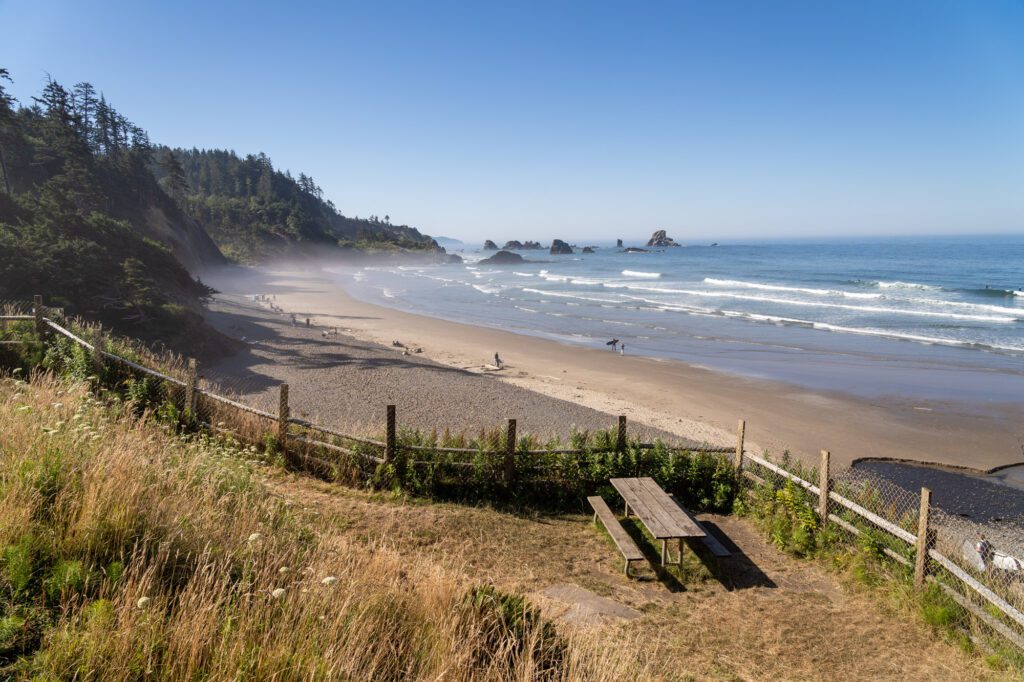
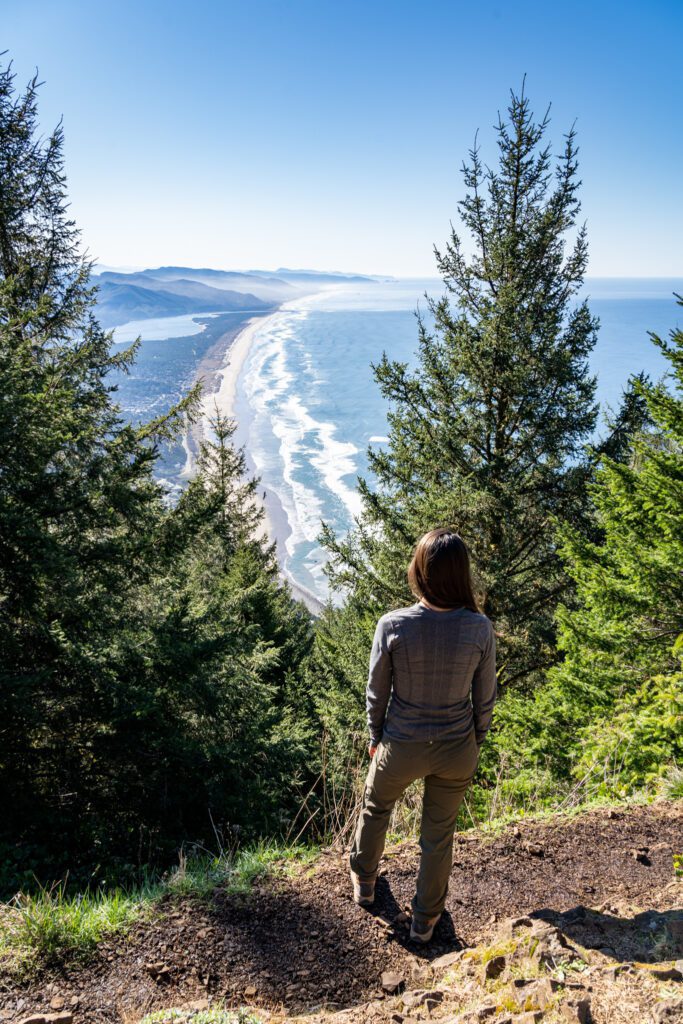
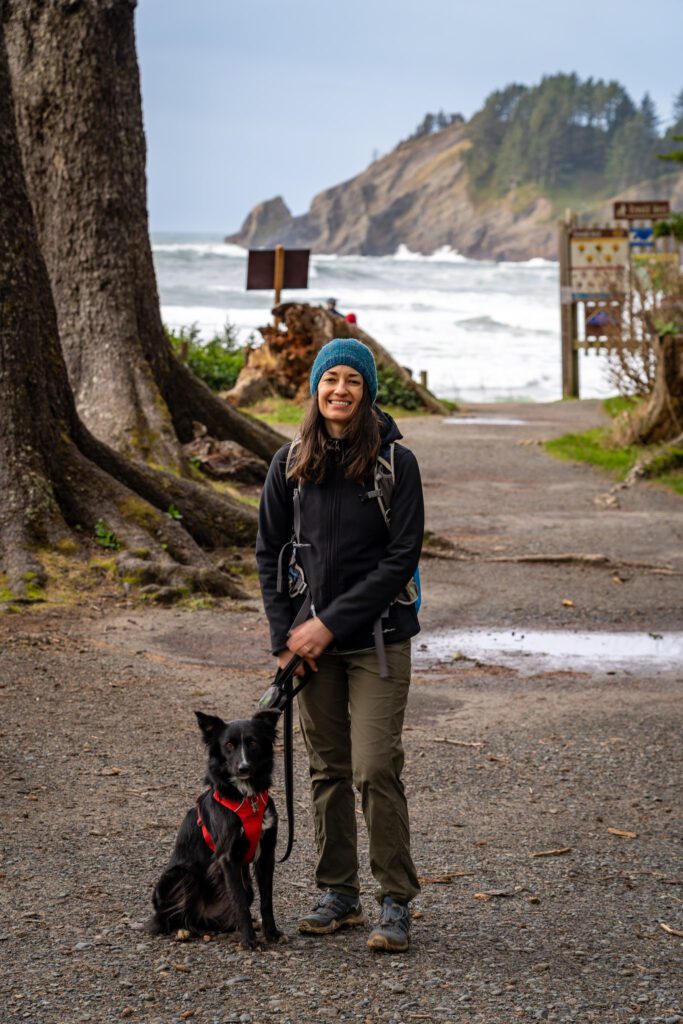
Days 3-4: Tillamook & the Three Capes Scenic Route
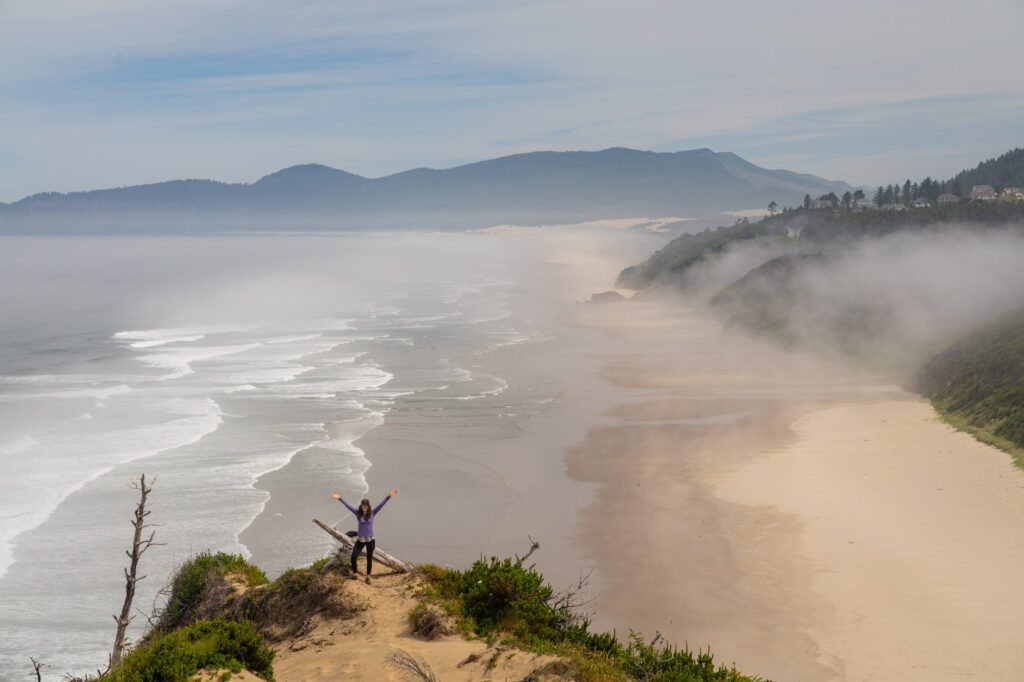
Drive Time / Distance from Cannon Beach to Tillamook: 55 minutes / 40 miles
Where to Stay in Tillamook: Tillamook itself isn’t really the nicest city, but there are some nice places to stay up and down the coast from town. We stayed in one of the tiny homes at Sheltered Nook, which is just north of the city, and really liked it (full kitchens, nice outdoor seating).
Everyone who has spent any significant amount of time in the Pacific Northwest knows Tillamook because of the cheese, ice cream, sour cream, or some other dairy product that every supermarket carries.
And while you’re in Tillamook, you should definitely visit their factory for a tasty, educational experience.
However, Tillamook is also home to the Three Capes Scenic Route, which is well worth a half day of your time to explore as well.
What to Do Around Tillamook
Here are three things not to miss when you’re in Tillamook.
The Three Capes Scenic Route: Like we mentioned above, this is probably the premier thing to do near Tillamook. The Three Capes Scenic Route covers a 30 mile stretch of the Oregon Coast from Cape Meares to Cape Kiwanda (Cape Lookout is between them, and rounds out the “Three Capes”) where you’ll have great coastal views around every bend in the road. If you’re following this itinerary as we’ve laid it out, you’ll be heading north to south.
- Cape Meares is your first stop, and there are two things to check out. First is the Cape Meares Lighthouse, which is the shortest lighthouse on the Oregon Coast. However, it has an impressive lens that was installed in 1890. The second thing not to miss is the Octopus Tree (it’s a weird looking tree with eight branches, hence the name) and the viewpoint right past it that looks out over the beaches to the south, including Short Beach. It’s a short walk from the main parking lot.
- Cape Lookout is your next stop, and is our personal favorite of the three. The highlight, by far, is the hike out to Cape Lookout. It’s a relatively easy hike that hugs the cape, which narrows as you get further and further out onto it before the trail ends at its western tip, where the views are amazing and you can hear the seals frolicking on the rocks below. It’s also a good place for whale watching in spring, because it’s about as close to the migrating mammals as you can get.
- Cape Kiwanda is the last of the three capes, and it’s a little different. It’s very popular with surfers, and you can drive out onto the beach, which means it’s a slightly different crowd that includes fishermen and boaters. From the parking lot, the main attraction is up and to the right of the beach, where you can hike up onto the cape for some great views in both directions. You’ll be hiking up in deep sand, so it’s harder than it looks. Make sure to catch the hang gliders, if they’re out, who use the northern end of the cape as a jumping off point.

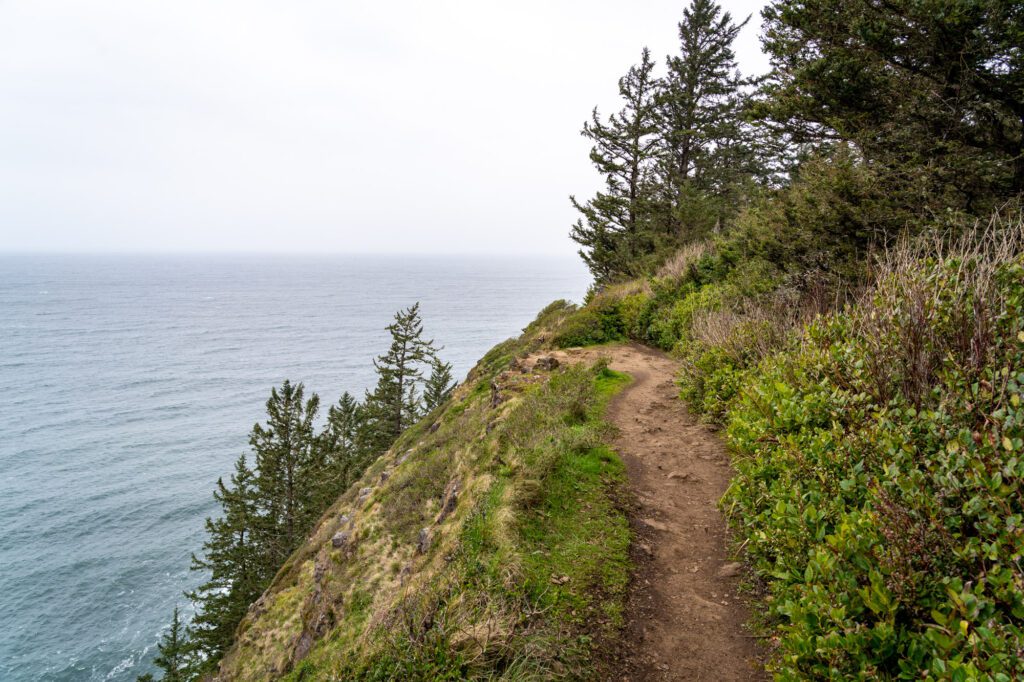
Tillamook Cheese Factory: The Tillamook Cheese Factory is legendary. Not only is there a cool educational experience where you can see how they make the cheese, but there are some truly great food options, including a huge ice cream scoop shop. If you’ve never had their ice cream before, it’s incredibly creamy. That’s their whole thing. The chocolate peanut butter swirl is Alysha’s favorite, with thick, creamy swirls of peanut butter tucked into their chocolate ice cream.They also have a retail store here, where you can buy all of their cheeses, including some of their hard-to-find reserve varieties, along with a selection of other local products. If they have them, do not miss their cheese curds, which are only available at the factory and are incredible (we’d never had them before we bought them a few years ago and fried them up post-hike over our camp stove – incredible).
More Cheese: There’s actually a second cheese destination down the road – Blue Heron French Cheese Co – though we weren’t nearly as impressed with the presentation. The cheese – which leans towards French style – is really good, though.
Hiking in Lincoln City: Technically this isn’t Tillamook – it’s 30-45 minutes south – but we’re including it here because two of our favorite hikes on the Oregon Coast are in and around the sleepy coastal community of Lincoln City. The first is Cascade Head, which is maintained by the Nature Conservancy (no dogs allowed). It’s a great hike that climbs through the forest and emerges onto a (very windy) bluff over the ocean, which you can climb up for some great coastal views. It’s windy as you get out onto the coast, so be prepared. The second is God’s Thumb, which is a short hike from the north end of Lincoln City that takes you out to a point, which looks out over the Oregon Coast both north and south. Along the loop, you’ll pass the Knoll, where you’ll have a great view of the neverending sandy beach that stretches out to the south.
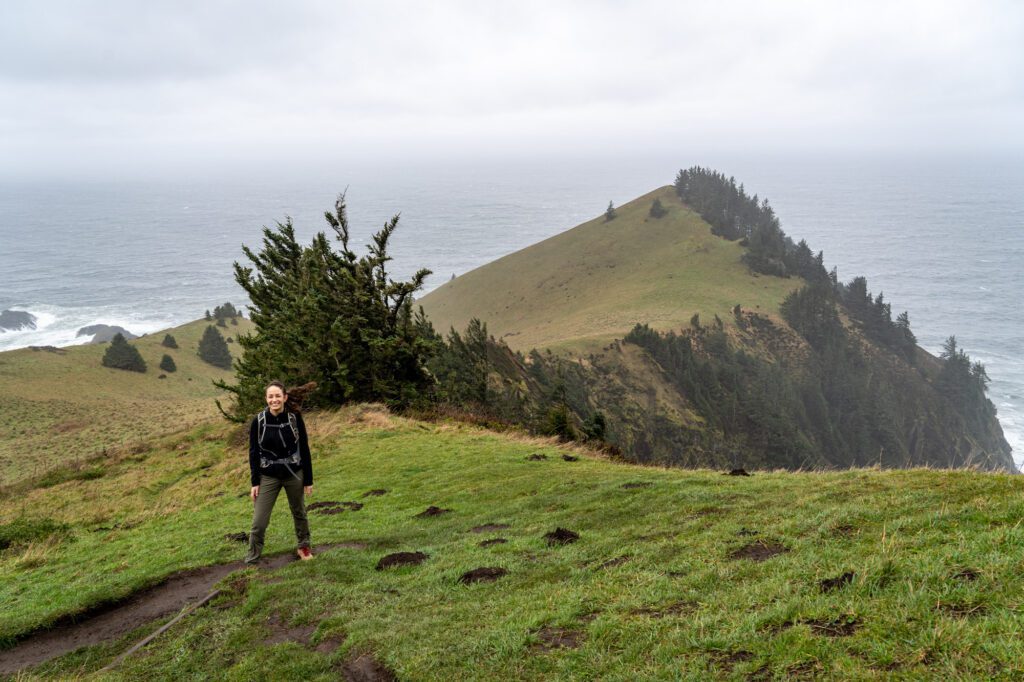
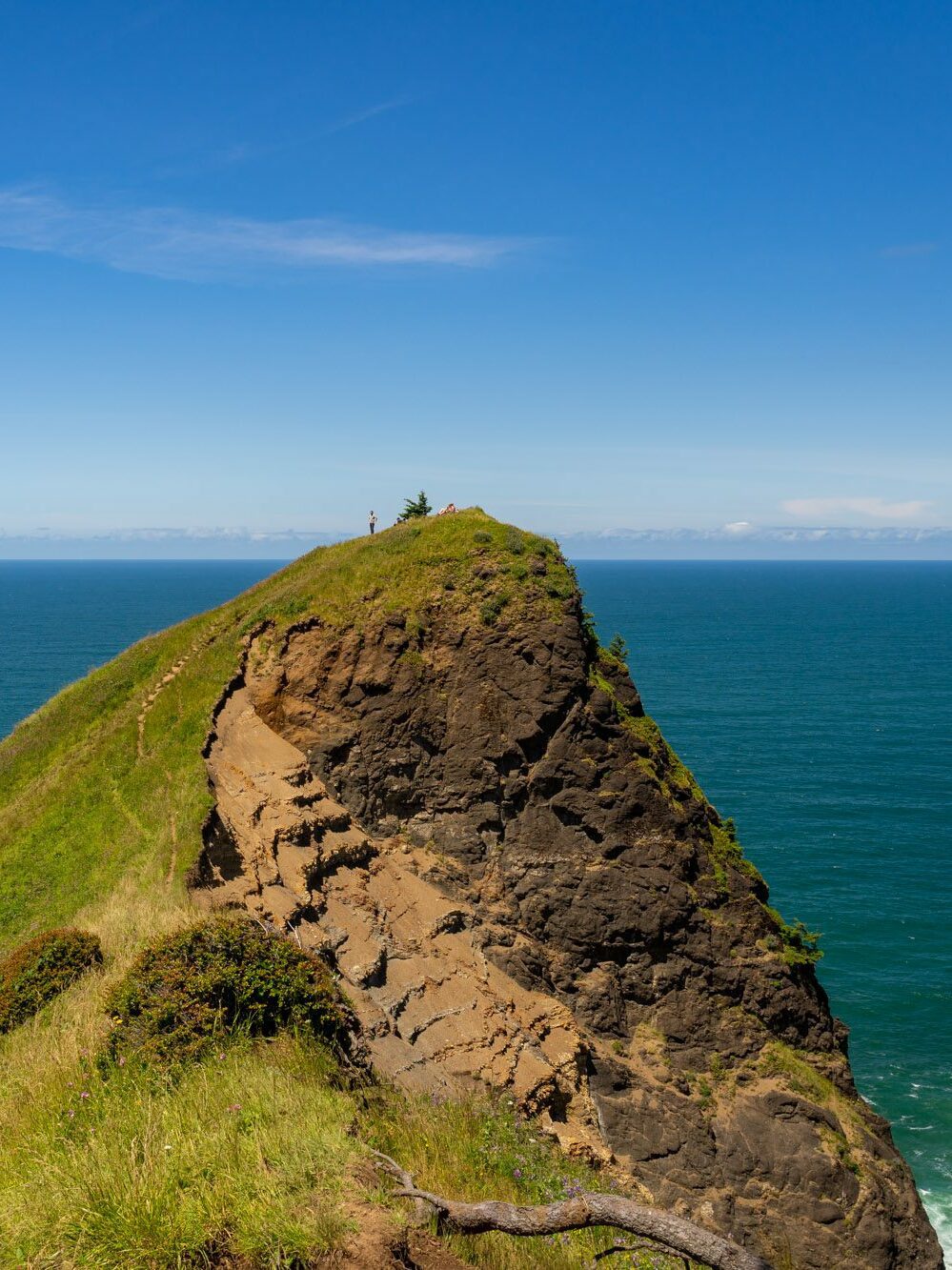
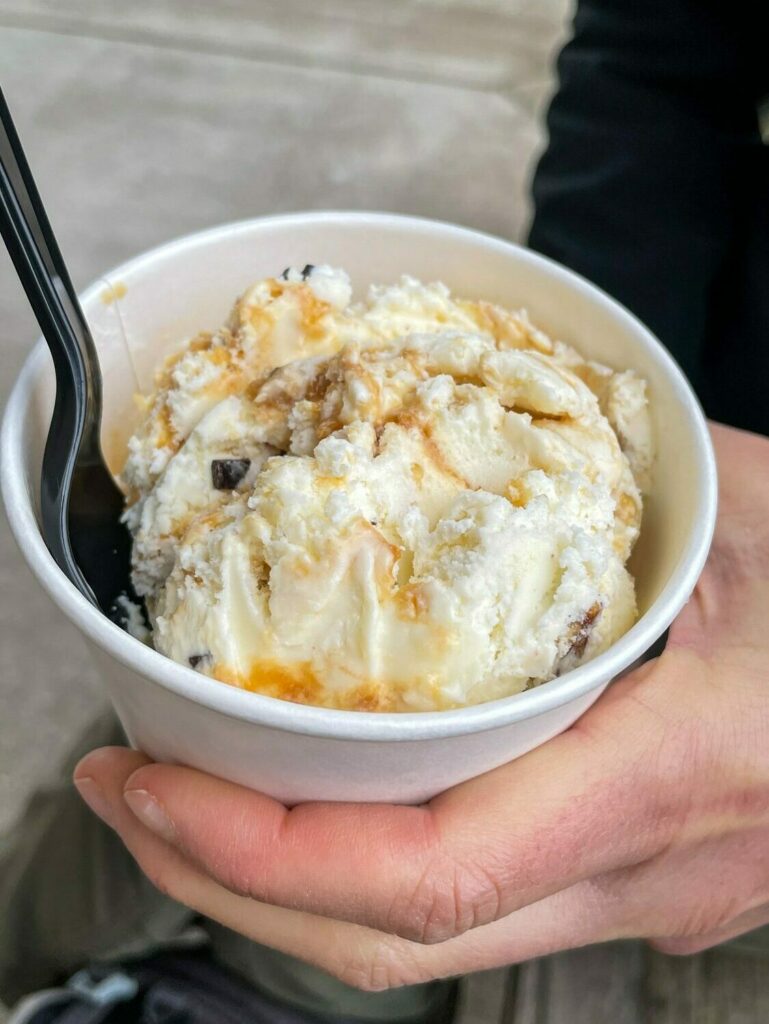
Day 5: Newport, Cape Perpetua, & Heceta Head Lighthouse
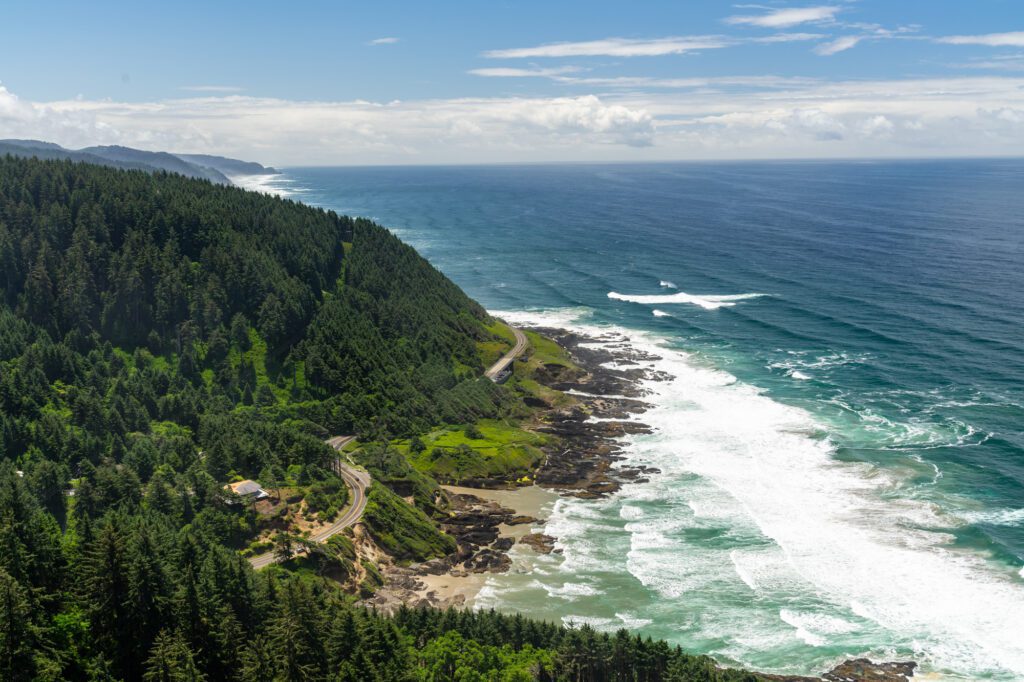
Drive Time / Distance from Tillamook to Newport: 1 hour 30 minutes / 70 miles
Where to Stay in Newport: We haven’t stayed there ourselves yet, but the Inn at Nye Beach has been on our list for years now.
Newport is the biggest city on the central Oregon Coast, and has the best selection of places to stay, restaurants, and other amenities like grocery stores before you get into the more rural southern Oregon Coast.
The structure for today is essentially using Newport as a home base to continue your road trip south along the coast past Newport (which is one of our favorite stretches of the Oregon Coast) and then returning to Newport for the night to set yourself up for a long drive the next day.
Just south of Newport, the coast starts its transformation from the very developed, very tourist-friendly northern Oregon Coast to the more rugged southern Oregon Coast, which is rockier, less-traveled, and offers a little more peace and quiet than places like Cannon Beach and Seaside.
From Newport, you can hit one of the most scenic drives on the coast – the area around Cape Perpetua and Heceta Head – before returning to Newport for the night to eat some fresh seafood and check out one of the many beaches in town.
What to Do Around Newport
Here are our favorite things to do in and around Newport.
Devil’s Churn: A short stop where you’ll hike down to an overlook with a view of an inlet that is partially covered at the end. Which means at high tide, if you’re lucky, the waves coming in will meet the waves going out and create an explosion of water.
Cape Perpetua: The view from the top of Cape Perpetua is one of our favorite views on the coast, and it reminds us a lot of Big Sur down on the California Coast (at least on a sunny day). You can hike from the lower road up to the top, which is a nice workout, but you can also just drive to the top (which we didn’t know until we got up there, sweaty and huffing and puffing). There really isn’t a reason to do the hike other than a workout – there aren’t really any additional views you get by hiking.
Heceta Head Lighthouse: This is one of the most beautiful lighthouses on the coast, and it’s easily accessible from the parking lot. It sits on a 1,000 foot headland that towers over the Pacific, and they have tours of the lighthouse, a charming B&B in the old light keeper’s home, and tidepools and trails to explore. You can hike out to Hobbit Beach from the lighthouse, which is a nice little trail that follows the coast to a sandy beach.
Sea Lion Caves: We drove past this place on our first trip, saw a line out the door of a tiny little touristy-looking hut, and said “look at those suckers!” Then we learned what it actually was later on from some Oregonians, and were at least a little bit disappointed that we didn’t stop in. If you want to see sea lions, this is the place to do it. That hut sits over an elevator that takes you down hundreds of feet to the water level, where there’s a sea cave – America’s largest, in fact – filled to the brim with barking sea lions. Skeptical? Here’s the webcam where you can see for yourself. They’re open 9:00 am – 4:00 pm 363 days a year, and it costs $16 for adults, $10 for kids (under 4 are free!), making it a little bit pricey.
Exploring Newport: Newport is probably best known for its world-class aquarium – the Oregon Coast Aquarium – which we stopped at and immediately turned around when we saw the flood of small children (it would be a good family activity, though!). There are two lighthouses in town, and the Yaquina Head Lighthouse is at the northern end of town, and is well worth a stop (the Yaquina Bay Lighthouse is less impressive). Definitely head down to the charming Historic Bayfront for dinner and the shops there (here on Google Maps) and head out to Agate Beach (here on Google Maps) for a good view of the lighthouse.
Day 6: Drive the McKenzie River Scenic Byway to Bend
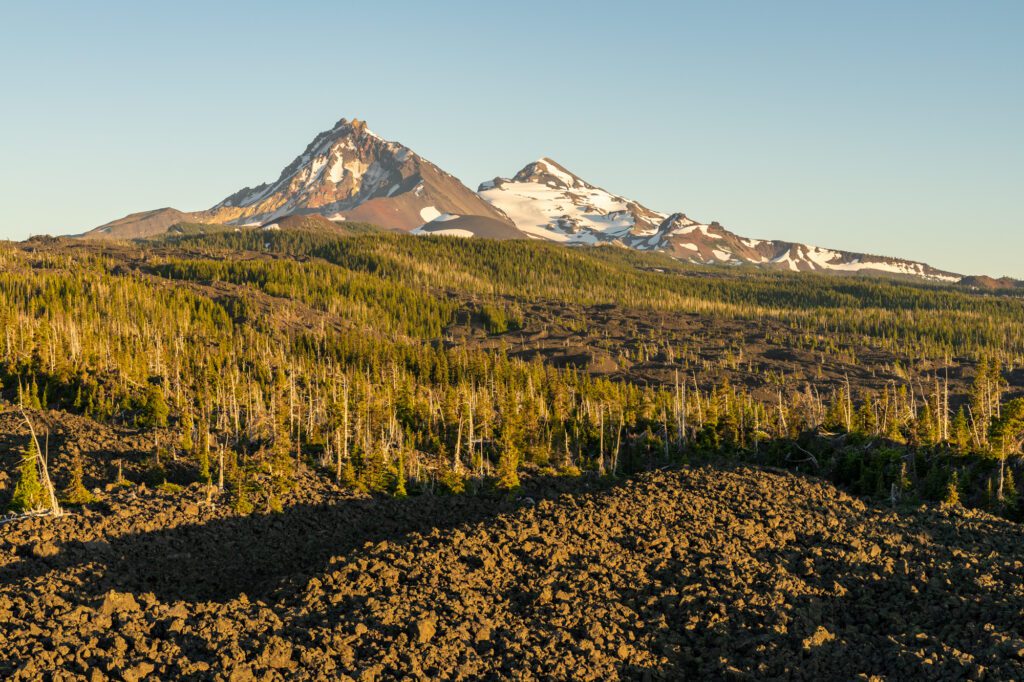
Drive Time / Distance from Newport to the McKenzie River: 3 hours / 130 miles
Full disclosure here: this part of the itinerary requires a long drive, but we think it’s worth it because this part of Oregon might just be our favorite in the entire state.
The McKenzie River Scenic Byway follows the path of, you guessed it, the McKenzie River, which is one of Oregon’s many important rivers. For your purposes, we’d recommend driving it from the I-5 corridor (you’ll take Highway 126 from Eugene, which connects you to Highway 242) all the way to the eastern end in Sisters.
It’s a gorgeous drive, littered with waterfalls, tight switchbacks, alpine lakes, and lava flows.
There are a few things you need to know about this stretch. First, it’s closed outside of summer and early fall (usually open between July and October).
Second, it’s a narrow one way road, so it might not be best for RVs or trailers.
This is going to be a long day of driving, but ultimately we think it’s worth the journey. At some point, you have to cross over the state from the coast over to the Cascades, and it’s going to take 2-3 hours, depending on how you do it.
We went back and forth on whether or not to add a night here in Eugene, which would cut down on the drive time, but ultimately we think your time is better spent on a long drive today to give yourself some extra time in other places (which we think are more worthy of your limited time than Eugene).
Note: You’ll spend the night in Bend tonight, so we’re skipping the “where to stay” section here.
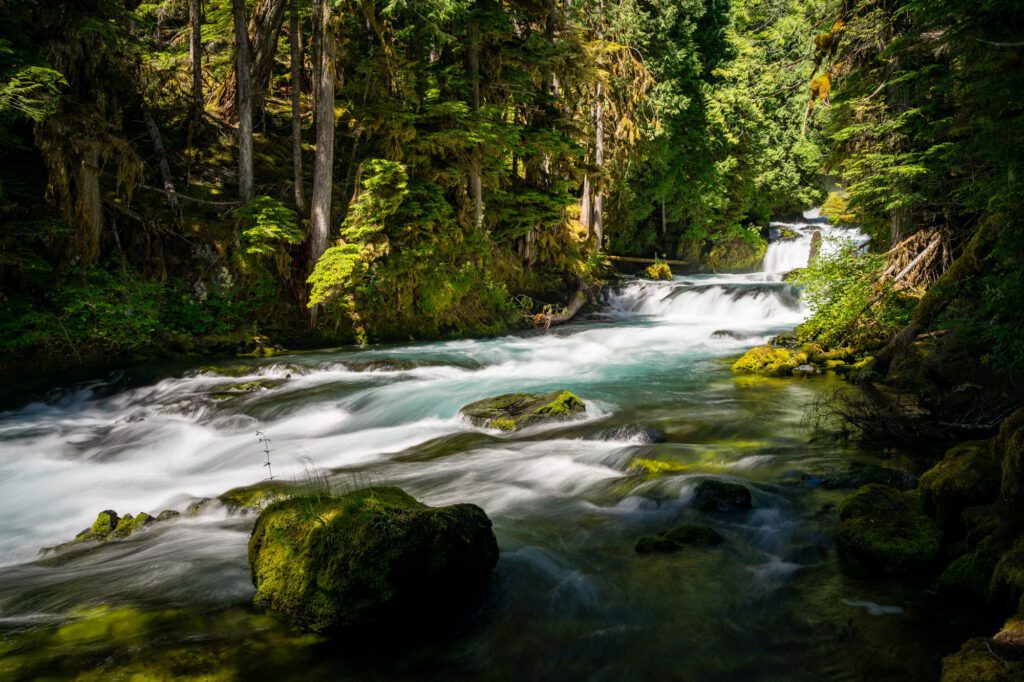
What to Do Along the McKenzie River Scenic Byway
Also, if you follow this itinerary as we’ve written it, you’ll be approaching from the west (coming from the Eugene area). We’ve organized the stops from west to east for that reason.
Proxy Falls: Over the course of this trip, you’re going to see a bunch of incredible waterfalls, especially as you get into the Columbia River Gorge later in the itinerary. Proxy Falls will likely be in your top three. It’s a short hike – roughly 1.5 miles – that takes you to a massive waterfall that cascades down the mossy rocks into Proxy Creek. You can do a loop that takes you to both Lower Proxy Falls and Upper Proxy Falls. The lower falls is the more impressive of the two, and the view from the base is incredible.
Scott Lake: This pristine lake is one of the spots we’re hoping to return to this summer. It’s a gorgeous lake with a perfect reflection of the Three Sisters (really two of the three sisters), one of the most distinctive natural features of central Oregon, and a bunch of first come, first served campsites along the lakeshore. However, the tradeoff here is the mosquitoes, which are intense in the early summer. For your purposes, we’d park along the lake and walk out to the western shore to get that reflection picture. It’s best in the afternoon, when the sun is behind you.
Dee Wright Observatory: As you ascend the tight switchbacks along the road as you pass Scott Lake, you’ll notice an abrupt change in the landscape. In what seems like a few minutes, you’ll go from dense evergreen forests to an open, rocky landscape. That shift is a result of a massive eruption of the Belknap Crater two millennia ago, and that dark rock stretching out as far as the eye can see is the resulting lava flow. The Dee Wright Observatory is an excellent stop not only to admire the lava flows, but because it gives you a great overview of the numerous rocky peaks surrounding you. This, my friends, is the heart of the Cascades in Oregon, and you’ll see the Sisters, Broken Top, Mount Washington, and Mount Jefferson, along with a handy key atop the Observatory to help you identify which is which.

Sisters: Sisters represents the end of the McKenzie River Scenic Byway, and the beginning of central Oregon and the high desert, which stretches for hundreds of miles to the east until you get into the Wallowas in eastern Oregon.
Sisters itself is a cute little town that’s a great base for adventures into the nearby Three Sisters Wilderness.
It’s a vaguely western-themed town, with some great spots to eat and drink (Sisters Coffee and Sisters Meat and Smokehouse are good stops) and a cute little downtown area where you can do some window shopping.
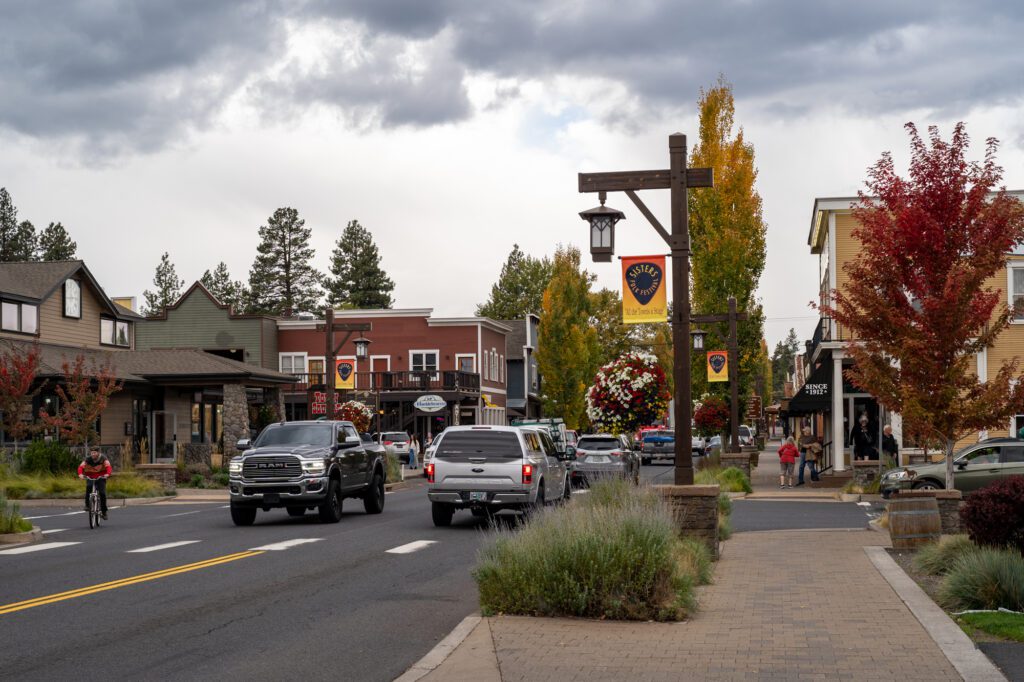
Days 7-8: Bend (and the Cascade Lakes Scenic Byway)
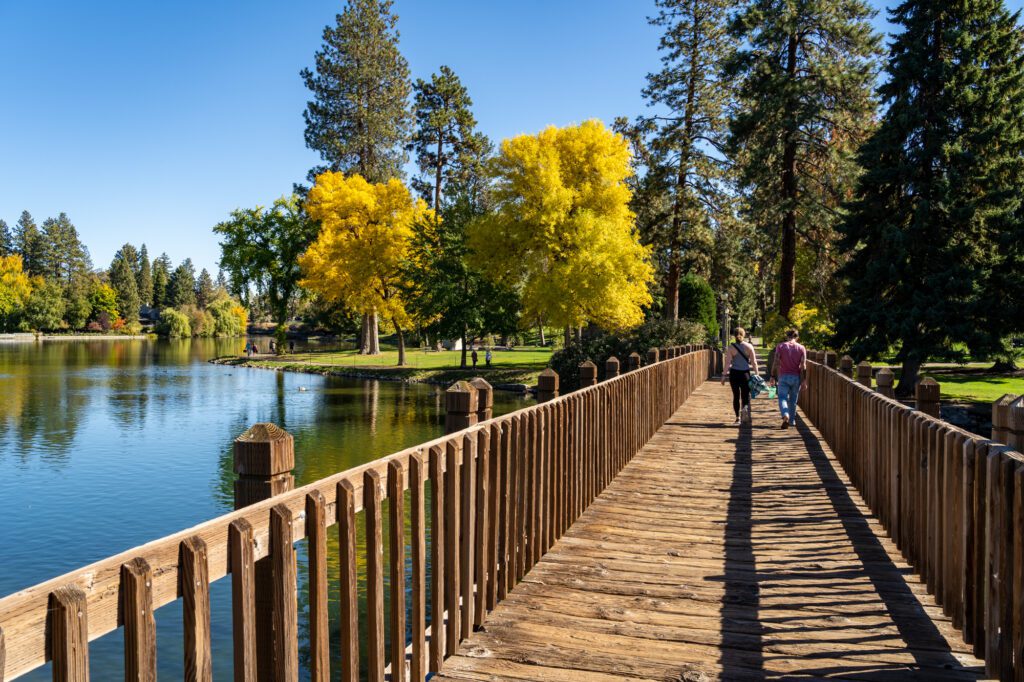
Drive Time / Distance from the McKenzie River to Bend: 1 hour 30 minutes
Where to Stay in Bend: This choice basically comes down to whether you want to be downtown in the heart of all the action, or in a quieter locale. Stay at the Oxford Hotel in Downtown Bend for the best location in the middle of the action. Stay at LOGE Bend – we’ve stayed at other properties they own before – if you want to be right near the Cascade Lakes Scenic Byway.
Over the past decade or so (though it seems like it happened overnight), Bend has gone from being somewhat on the map, to being one of the most famous outdoor destinations in the western United States.
As you drive through the Cascade Mountains into the heart of Central Oregon, you’ll notice that the landscape starts to change.
First you hit the eastern foothills, which are notably more dry than the western foothills, and as you continue to Bend and beyond, you’ll be right in the heart of the high desert that stretches across Central Oregon.
Bend is perfectly placed between the mountains and the high desert. Within 45 minutes or so, you can be in the heart of the alpine paradise in the Cascades, or hiking through the desert dodging rattlesnakes in Smith Rock State Park (more on that in a second).
Within 45 minutes or so, you’ve got great hiking, cycling, skiing, watersports, and more. Plus, Bend itself has a pretty good food scene, the Deschutes River and all the watersports it has to offer, and perhaps the best selection of breweries in the country.
What to Do in Bend
Here are some things to do in Bend, including some of the things to do just outside of town along the Cascade Lakes Scenic Byway.
Hikes Around Bend: Within the Bend city limits, there are a few good hikes (we’re not counting the hikes in the mountains or at Smith Rock, which we have separate sections for below). Pilot Butte is right in the middle of town, and after a quick ascent you have a panoramic view of the surrounding landscape that serves as a nice introduction to Central Oregon’s geography. To the west, you’ll be able to see the snow capped peaks of the Cascades (there’s a topographic map to help you identify which peak is which). To the east, it’s a lot of flat land. We also have hiked pieces of the Deschutes River Trail, which heads south out of town along the river. You could follow the trail for miles and miles, but there’s a nice 2.7 mile loop that focuses on the part of the trail near the Old Mill District that would be a lovely way to spend a morning. It would look something like this. If you want something a little longer, continue south from Farewell Bend Park, which is where the trail gets a little less developed. For more information, read our guide to hiking in Bend.
Explore Downtown Bend: Downtown Bend is centered around Drake Park along the Deschutes River (there are several areas that could be confused as “downtown” so we wanted to clarify). There’s also the Old Mill District, which is a little bit south (and has more chain retailers and Red Robin vibes, if you know what we mean), and the Box Factory, which is between them. In downtown Bend, go to Lone Pine for coffee, The Lemon Tree for brunch (it’s popular so go early), and Bontà for gelato. Then, poke your head into the many shops and boutiques along NW Wall and NW Bond.
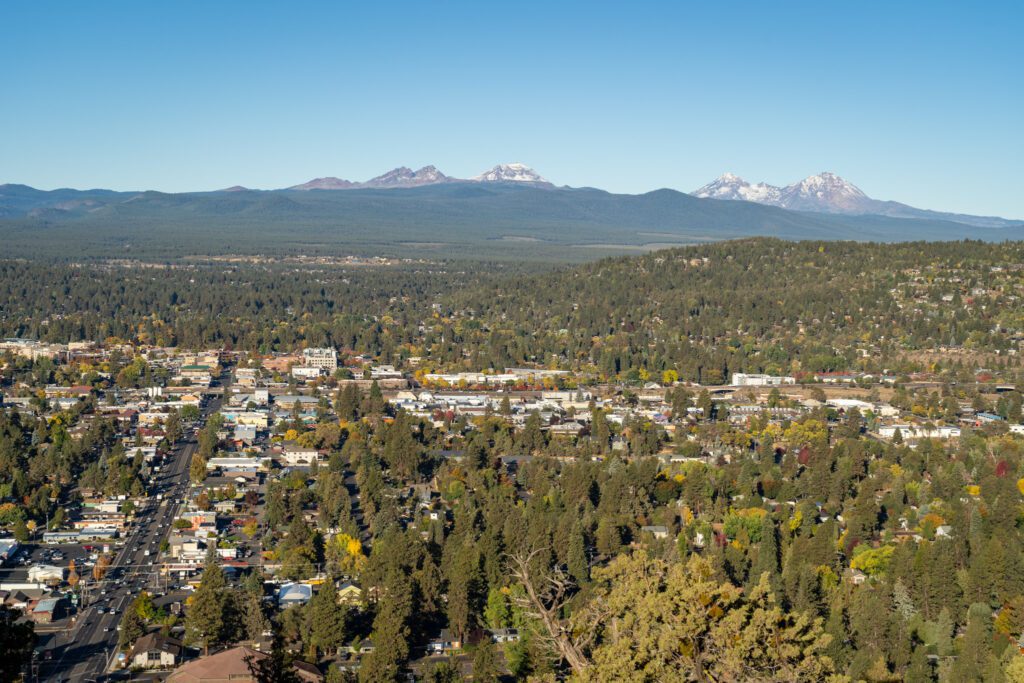
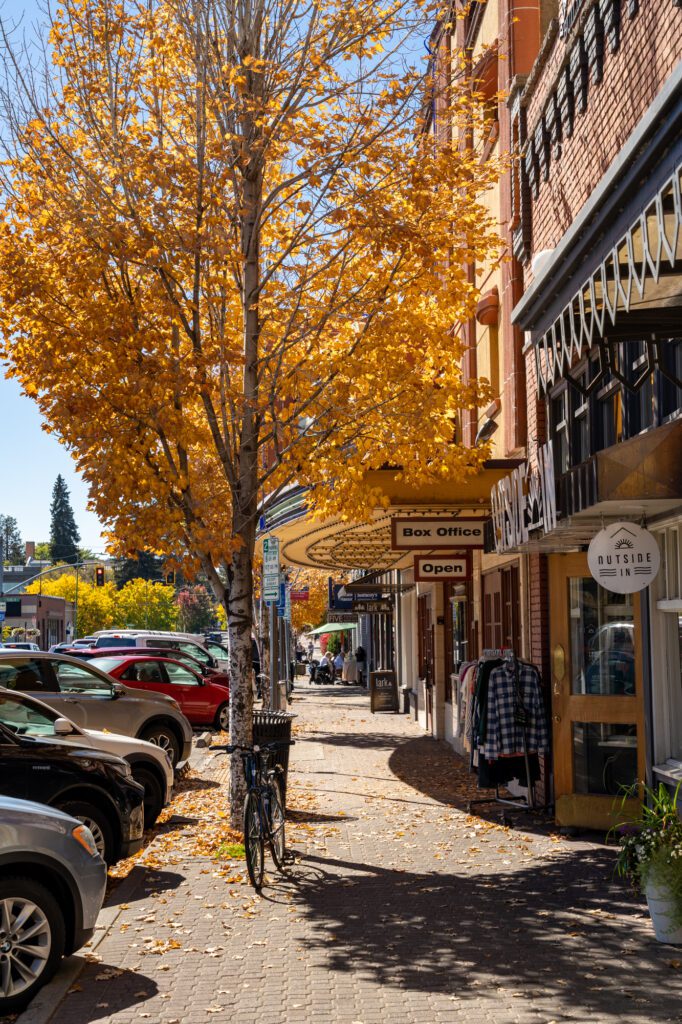
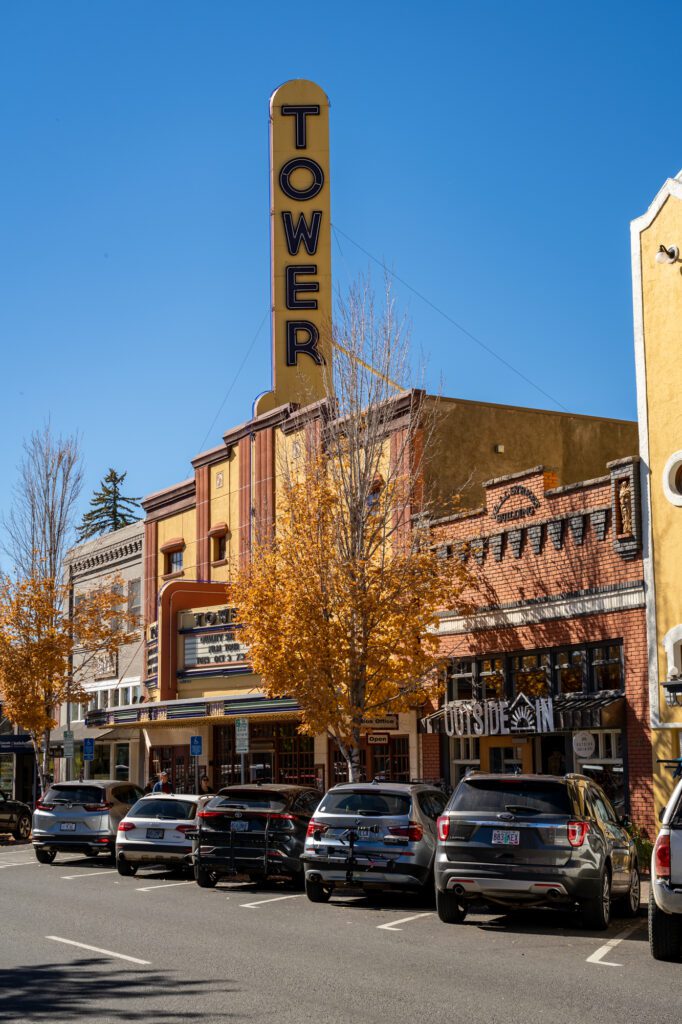
Brewery Hopping: Bend, like Portland, is known for its breweries. And like Portland, there are way, way too many breweries to visit in just a couple days. Here are a couple that we like for one reason or another.
- Deschutes Brewing: In many ways, the OG Craft Brewery in Bend that set off the craft beer craze in Oregon. It’s still owned by the original owners (rather than Anheuser-Busch), which is cool. They do tours (which we’ve done and enjoyed), and they have an onsite taproom with beers that you can’t find elsewhere.
- Silver Moon Brewing: A cozy taproom outside of town – we like them for their Thursday trivia nights! They have a cool space that has both indoor and outdoor seating with a lineup of live music in the summer. They also have a couple of food trucks onsite.
- Crux Fermentation Project: Our friends who are beer nerds think this is the best beer in Bend (though they also note that there’s too many and they’re too different to really choose). What we like about them is their HUGE outdoor terrace, which is a perfect place for some cold beer after a morning of hiking.
Cider in Bend: If you’re more into cider (we are!), the small town of Tumalo just north of Bend has a couple of our favorite cideries in Oregon, and they’re just around the corner from each other. The first is Tumalo Cider, which has a nice taproom and great, dry ciders. The second is Bend Cider Company, which has a new-ish taproom a couple of blocks away. They do fun flavor combinations featuring fruits and botanicals (but not too sweet!) – we liked the Blackberry Ancho we tried recently. There’s a food cart pod across the street from Tumalo Cider which would make a good stop for lunch between cider tastings.
Tumalo Falls: Honestly, the hike to Tumalo Falls kind of sucks. But the waterfall is cool, so there’s that! It’s a 97 foot high plunge into Tumalo Creek, and if you do the six mile hike, you’ll reach the viewing platform and realize that it’s a five minute walk from the upper parking lot. We’d drive to the parking lot and check out the falls, saving your energy for a more interesting hike (there are many!) later.

Explore the Cascade Lakes Scenic Byway: This scenic drive (also known as Highway 372) leaves Bend, heading southwest out into the alpine paradise that is Deschutes National Forest. Skiers and snowboarders familiar with Oregon will know this stretch because it takes you out to Mount Bachelor, one of the state’s premier skiing destinations. Which, if we think about our other favorite hiking spots in the Pacific Northwest, is a great indicator of a good summer hiking destination. It’s worth spending a day driving the byway, starting in Bend and working your way down to Elk Lake before returning the way you came. You could also do a loop, taking NF-40 back towards Bend, but we’d prefer driving the more scenic byway both ways. This is a very popular stretch, and there is a permit you’ll need to enter during the peak summer season.
Hiking Along the Byway: The Cascade Lakes Scenic Byway is full of great hikes, particularly as you get out past Mount Bachelor. Here are a few good ones.
- Green Lakes Trail: Potentially our favorite hike in central Oregon (technically it’s in the Cascades, so does that count as central Oregon?), this hike has everything we love about hiking in Oregon. Following a babbling creek the entire way, which is the perfect white noise for a hike? Check. Pristine alpine lake (really, lakes)? Check. All sorts of peaks to admire? Check. It’s 9 miles, but it’s an easy 9 miles, we think.
- Tumalo Mountain Trail: A tough ascent, but the views from atop Tumalo Mountain are worth the sweat. You’ll have Mount Bachelor, the South Sister, and Broken Top right in your face, with various other peaks peeking out behind them. It’s basically straight up, straight down.
- If you’re really up for a challenge, there are two excellent but difficult hikes here: Broken Top & No Name Lake and the South Sister. Both are very difficult, and should not be underestimated. The South Sister is going to be better if you can backcountry camp the night before at Moraine Lake or Green Lakes, which cuts down your ascent (but requires an extra night of backpacking, and all the associated gear).
Sparks Lake: We love Sparks Lake. The main photo on the homepage of this site (at the time of writing) was taken there on an early summer morning just after sunrise. Head to the day use area, park, and walk along the southeastern shore of the lake, where you’ll be treated to an absurdly good view of the South Sister and Broken Top, with a reflection in the still water of the lake if you’re lucky.
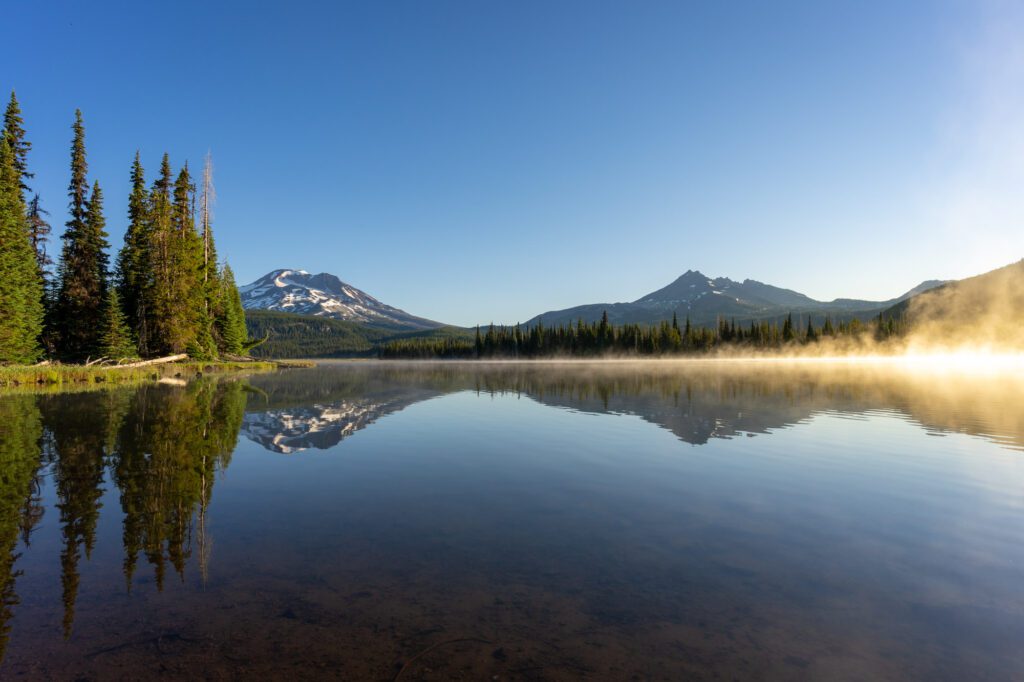
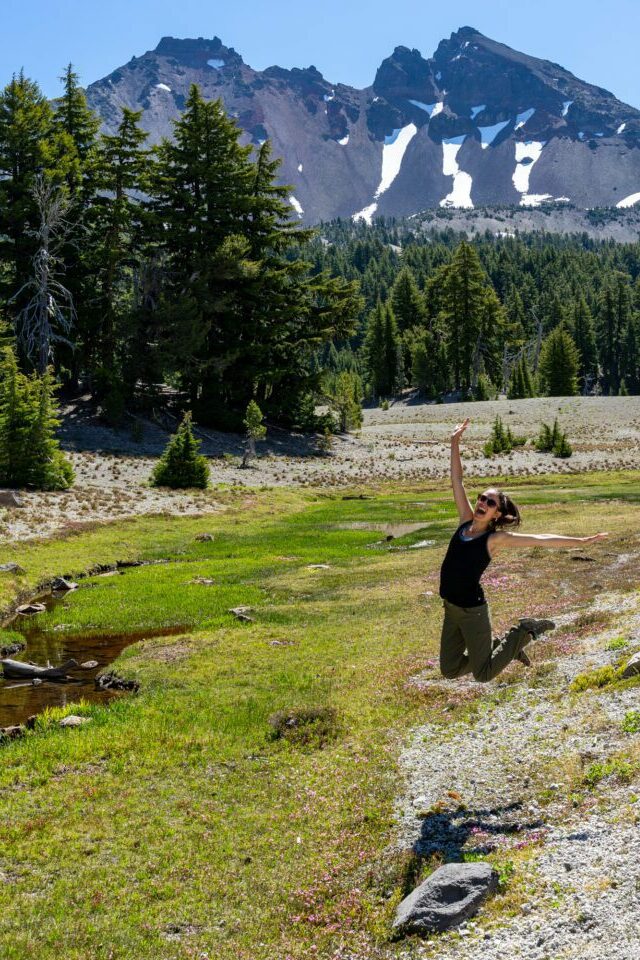

Day 9: Smith Rock State Park (and Drive to Government Camp)

Drive Time / Distance from Bend to Smith Rock State Park: 36 minutes / 23 miles
I will never forget the first time that I laid eyes on Smith Rock State Park during a spring trip to Bend with friends. I had only really ever been to Bend to go skiing in the winter at that point, which had us out in the forest to the city’s west at Mount Bachelor.
Smith Rock, with its winding river snaking its way between orange-hued rock formations, looks like it belongs somewhere in Utah or Arizona, not in Oregon. At least in my mind, having never explored Oregon east of the Cascades at that particular point in my life.
Bend is perched in the eastern foothills of the Cascades, and it is situated between the lush evergreen forests that cover the western part of the state, and the high desert that covers most of central and eastern Oregon.
Remember at the beginning of this guide, when we said that Oregon is the ninth biggest state in the country? Bend is about 25% of the way from the western border (the coast) to the eastern border with Idaho. Which means the high desert stretches for a LONG time from Bend to the east.
Smith Rock State Park is a destination that is definitely worth stopping at, but it’s not worth an entire section with separate things to do and places to stay. Instead, we’d recommend a stop on the way from Bend up to Mount Hood. It’s a perfect location for that.
There’s really only one hike in Smith Rock State Park – though you can do it two ways – and that’s the Misery Ridge Trail. It’s accurately named, because the initial ascent up to Misery Ridge is brutal, especially on a hot summer day with full exposure to the sun.
The views from the top of the ascent, though, are worth the price of admission. You’ll have a panoramic view of central Oregon, with the snowy peaks of the Cascades to the west, and the high desert stretching out as far as the eye can see to the east.
On the descent, you’ll pass Monkey Face, a very popular destination with rock climbers. It is also accurately named, because from a certain angle, it looks exactly like the face of a monkey.
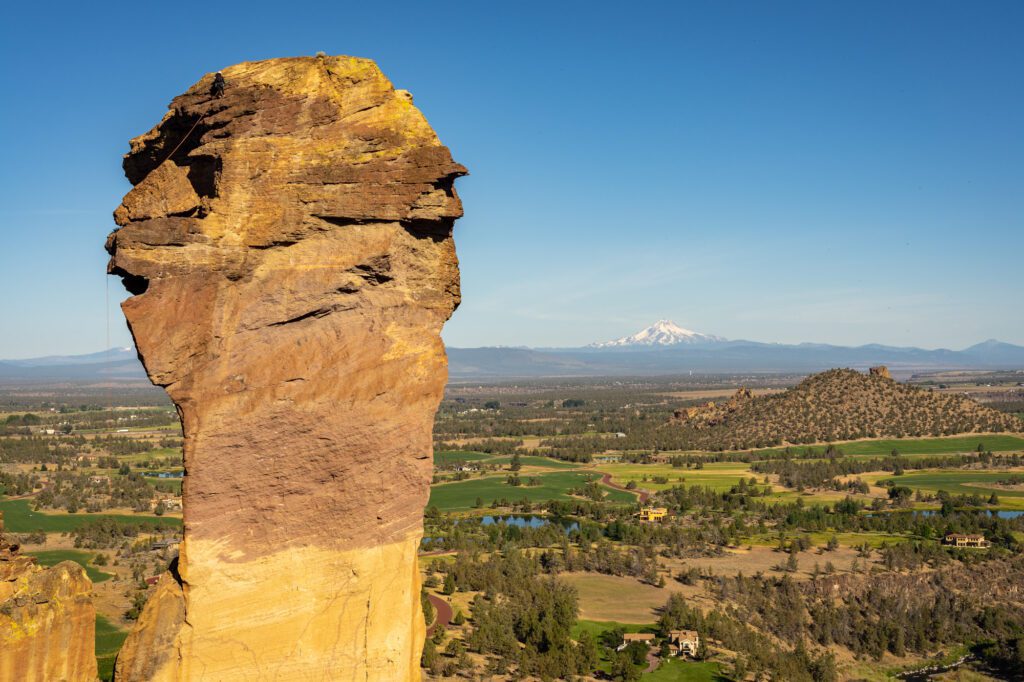
The trail descends back down to the river, where you can either head left to return on the River Trail (shorter and flatter) or right to continue on the Summit Trail (longer with better views and more climbing) to finish the loop.
Note: This is another place where you’ll stop along the way to another destination – in this case Mount Hood – so you’ll spend the night in and around Government Camp after your exploration of Smith Rock.
Days 10-11: Mount Hood (Government Camp)

Drive Time / Distance from Smith Rock to Mount Hood: 1 hour 40 minutes / 86 miles
Where to Stay at Mount Hood: There aren’t that many places to stay here, but you do want to be in or around Government Camp on the south slopes of the mountain. There’s a Best Western, a campground at Trillium Lake that we like, and a bunch of nice cabins in the woods to choose from.
Mount Hood is our favorite hiking destination within a couple of hours of Portland. We fell in love with it on that first road trip that eventually led us to move here, and we go back there as often as we can.
Matt is from Seattle, where the towering peak of Mount Rainier is a near constant reminder of the natural beauty that lives just outside of the sprawling city (and also a constant barometer of the weather – “is the mountain out?” is a common question to evaluate whether it’s a nice day in Seattle).
Mount Hood plays a similar role for Portland, and we often have a similar conversation around Portland around whether Hood is out.
During the winter, Mount Hood is home to some of Oregon’s best skiing. Then, when the snow melts in the late summer, it turns into a veritable alpine wonderland, with wildflowers blooming, roaring waterfalls, and stunning vistas of Mount Hood around every bend in the trail.
The part you’re going to want to focus on here is the area in and around Government Camp, on Mount Hood’s southern side.
That’s where all the action is, though that’s not to say there aren’t worthwhile places to visit on other sides of the mountain.
By focusing there, you’re also nicely positioned for the next stop on your itinerary, Hood River, where you’ll just hop back on Highway 26 and continue north to Oregon’s northern border.
What to Do at Mount Hood
Here are some of our favorite things to do and see near Mount Hood.
McNeil Point (or Bald Mountain via Lolo Pass): For some of the best views in Oregon, you should hike one of these two trails. However, be warned, the hike up to McNeil Point is no joke. Not even a little bit. We did it at the peak of our hiking powers, during a summer where we were hiking 7-8 miles almost every day, and it kicked our butts. With that warning out of the way, it’s a fantastic hike. It takes you up to an alpine wonderland on Hood’s northwestern slope where you’ll have unobstructed views of the mountain, and you’ll feel like you’re close enough to reach out and touch it. The full hike to McNeil Point is a 10 mile lollipop – you should do the lollipop section counterclockwise because it involves a scramble that is easier to do uphill (you can also go around and make it an out and back, but it’s about 2 miles longer).
Our favorite view in Oregon is the view from Bald Mountain: You’ll find it plastered all over this website – which you can access either on the way up to McNeil Point, or as a different, much easier hike from the Lolo Pass Trailhead. That’s a good shorter option that is more accessible for more hikers.
Ramona Falls: If you want a waterfall hike, this is it. Don’t let the 7 miles scare you off – it’s a pretty easy hike with the exception of the crossing of the Sandy River, which used to have a bridge, but has since been relegated to “I don’t know, find your own way across.” It’s not an easy one, though it is worth noting that hundreds of hikers do it every day in the peak of the summer. There are various logs, and some narrower sections of the river a bit upstream from the trail where you can make the crossing. We wouldn’t take our dog, though. Ramona Falls, unlike some of the waterfalls in the Columbia River Gorge, is a wide cascading falls that dribbles down a rock wall rather than plunging down into a pool. Still, it’s very impressive, and it’s 120 feet tall – tall enough that it’s hard to get the whole thing in frame on a photo without a wide angle lens.
Timberline Lodge and the hike to ZigZag Canyon: The iconic Timberline Lodge is an uber-rustic lodge that is reminiscent of the various national park lodges in the American West. It was built in 1937, and has since been declared a National Historic Landmark. If you’re up for a splurge, their rustic rooms would be a fun place to stay. However, even if you’re not staying here, it’s worth coming up to do some exploring on the trails around the lodge (in the summer, anyway, it’s a ski resort during the winter months). Our favorite of the bunch is a piece of the Timberline Trail, which circumnavigates Mount Hood, and it’s the stretch between the lodge and Zigzag Canyon. It’s a beautiful, somewhat easy hike that ends with a view of the peak up a canyon.
Trillium Lake: This is our favorite campground in Oregon, although it’s also one of the most competitive. We’ve camped here a few times, and we’ll do it again. The draw here is the excellent views of Mount Hood, often reflected in the surface of the lake, which you can find from the southern end of the lake near the day use parking. It’s also a great place to bring watercraft like kayaks and stand up paddleboards in the summer.

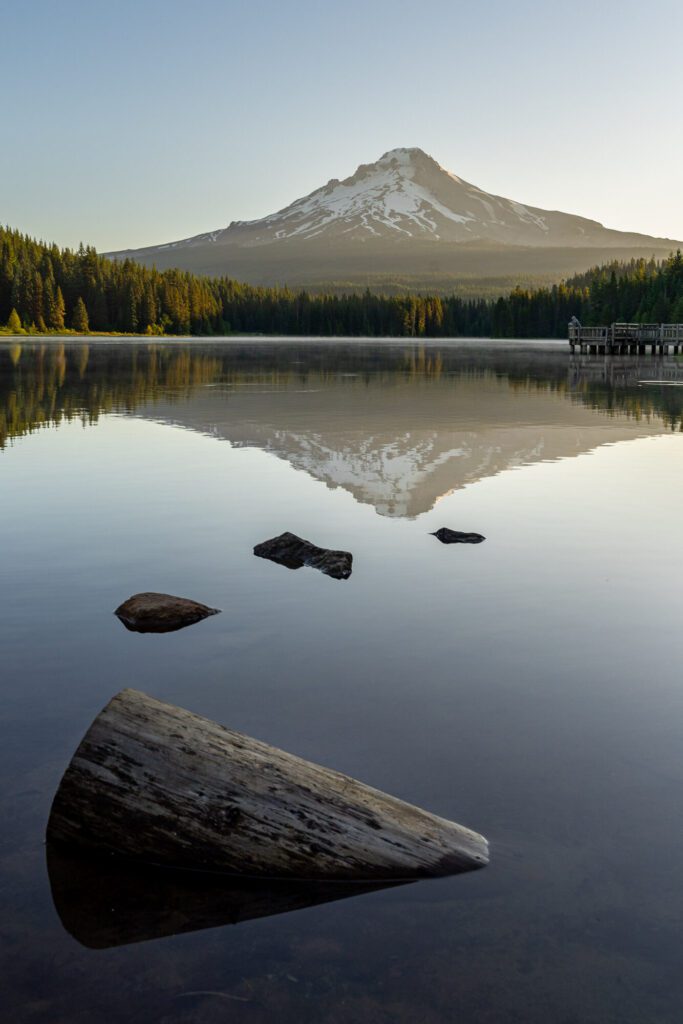

Days 12-13: Hood River and the Columbia River Gorge

Drive Time / Distance from Government Camp to Hood River: 50 minutes / 43 miles
Where to Stay in Hood River: Hood River is a very nice little downtown area, and there aren’t that many places to stay downtown. We actually like staying across the river in Washington, either at the Society Hotel in Bingen or at the lovely RubyJune Inn (a very charming B&B in a tranquil setting run by lovely people).
The Columbia River Gorge runs along the northern border of Oregon (it separates Oregon from Washington State), and has the highest concentration of waterfalls in the state.
Depending on how good your memory is (and how long ago high school was for you), you may remember the Columbia River from your days learning about Lewis and Clark, because it’s the river that they came up as they made their way out to their final destination just south of Astoria.
Living in Portland, the Columbia River Gorge is essentially our backyard. It takes 30-40 minutes for us to get out there, and when we’re looking for an easily accessible hike for a random Thursday morning, this is generally where we’re heading.
It’s also on our itinerary for every single first-time visitor who comes to Portland to visit us.
There is a nice mix of different hikes in the Columbia River Gorge, from easy waterfall hikes to hikes that climb to the rim of the Gorge, where you’ll find dramatic vistas out over the Columbia River and the gorge beyond.
Hood River is a town in the Columbia River Gorge, and it is perched at a crossroads of sorts. It sits at the point where the wet, temperate climate of western Oregon transitions to the dry, more extreme climate of the high desert in eastern Oregon.
To the west, you’ll find some of the best waterfalls in Oregon. To the east, the high desert. And both north and south are the Cascade Range, and places like Mount Hood and Mount Adams.
There are a bunch of great things to do in Hood River, and that list grows longer when you include the fertile Hood River Valley and its fruit trees as far as the eye can see and the wineries along the Columbia River.
Hood River is a great home base to use to explore the Gorge and the fertile Hood River Valley, which is what you’ll be doing for this stretch of the itinerary.
Note that we’ve split the “what to do” sections below into Hood River and the Columbia River Gorge to make it easier for you to plan and group things together.
What to Do in Hood River
Here are a few of our favorite things to do in and around Hood River.
Tamanawas Falls: This hike is on the eastern slopes of Mount Hood, and would be an excellent stop between Government Camp and Hood River. It’s right on Highway 26, and it’s a nice, easy hike up to a spectacular waterfall. Parking is limited, so you’ll want to get there early, or be prepared to wait for a spot in the tiny lot – parking along the highway is illegal, and we’ve seen many people get tickets here.
Read More: Everything You Need to Know to Hike the Spectacular Tamanawas Falls Trail
Drive the Fruit Loop: The Hood River Fruit Loop is a perfect half-day activity near Hood River that takes you through the fertile Hood River Valley, with apple and pear trees as far as the eye can see (with backdrops of Mount Adams, Mount St. Helens, and Mount Hood). There are a bunch of worthwhile stops here, but our favorite is Draper Girls Country Farm, which does u-pick cherries for a short window in the summer, and has all around excellent produce more or less from spring to fall. They have a lovely back patio area with great views of Hood, and a lush collection of various fruit trees. Plus, a great selection of locally made jams, honeys, and other stuff inside the shop.
Wine Tasting near Hood River: The area around Hood River, both on the Oregon side of the Gorge, and on the Washington side, is a great place to grow grapes and make wine. There are a bunch of wineries in Hood River itself (Hood River Common House is a good spot), but the real way to do it is to hop in the car and drive out to one of the wineries dotting the landscape around Hood River. We like the Gorge White House (not the best wine and cider, but the setting is amazing) and Loop de Loop (the friendliest wine makers and the best dog, plus an amazing view), and have also heard good things about AniChe Cellars, Le Doubblé Troubblé, and Analemma Wines (this one came highly recommended from the folks at the Ruby June Inn, where we stayed on our recent trip).
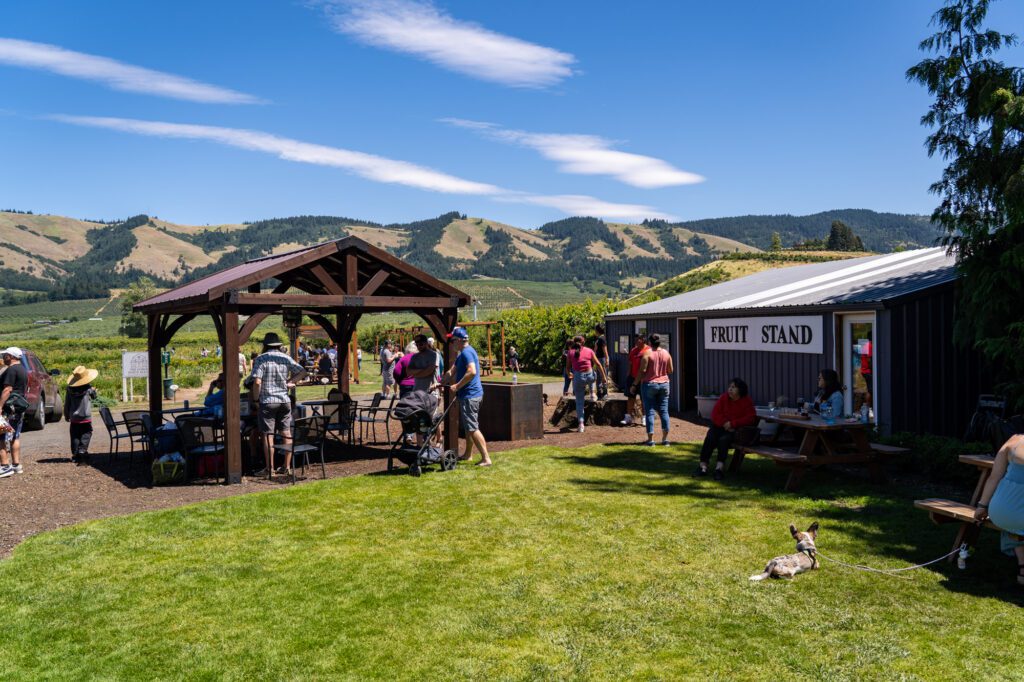
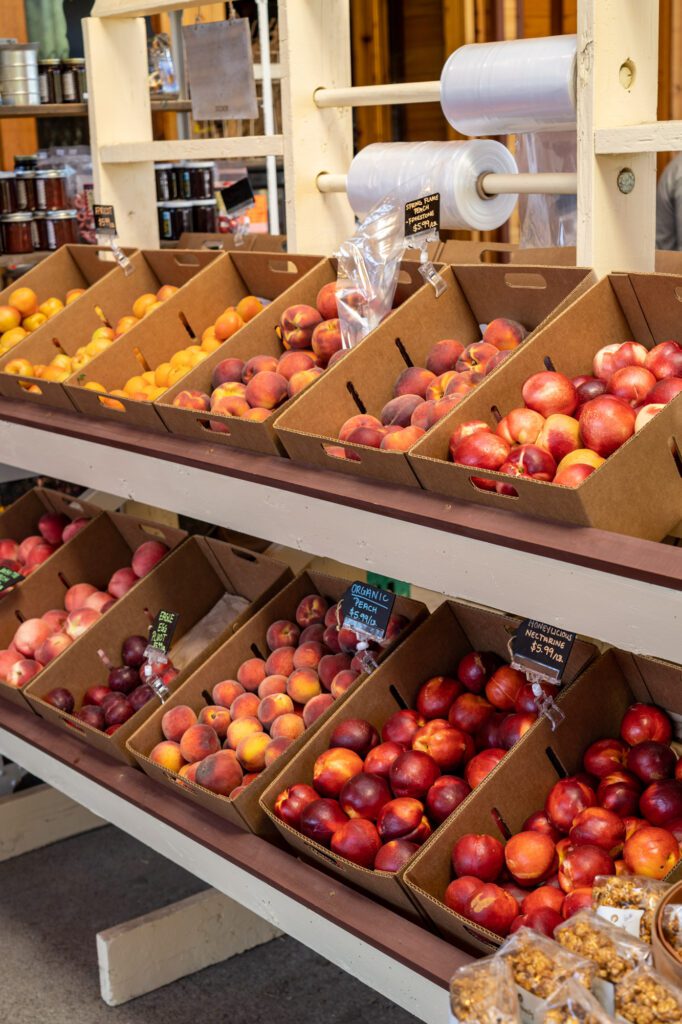
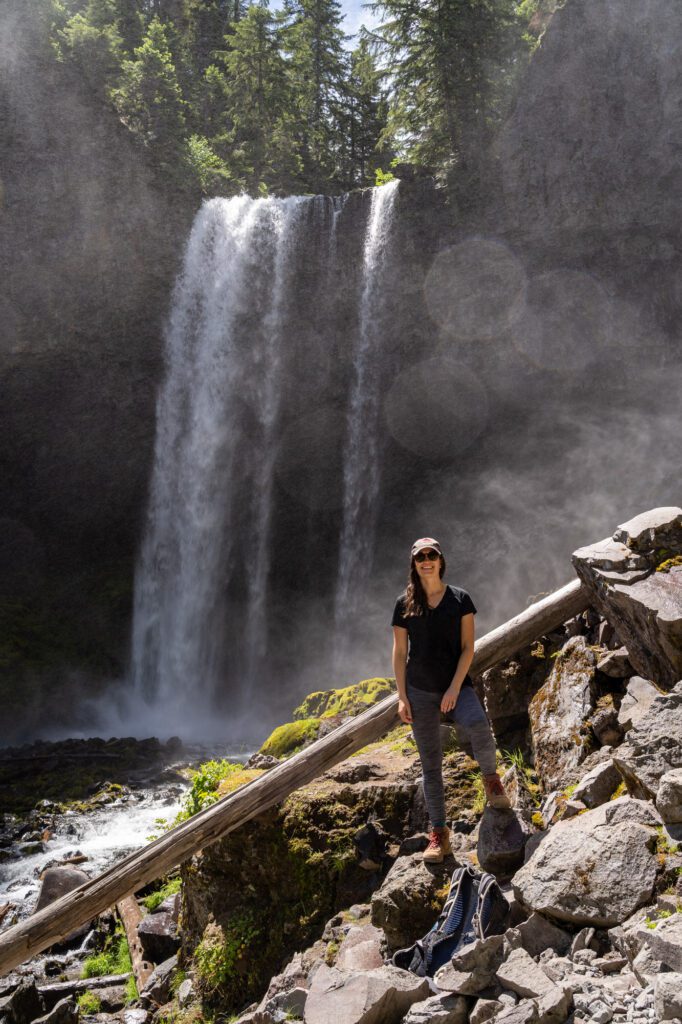
What to Do in the Columbia River Gorge
Here are our favorite stops in the Columbia River Gorge.
Wahclella Falls: This is the best bang-for-your-buck waterfall adventure in the Columbia River Gorge, we think. Multnomah Falls is great, yes, but it’s an absolute zoo at all hours. The short and easy hike out through a canyon with steep rocky walls here weeds out most of the visitors, and you end up at a beautiful waterfall that tumbles off of a ledge into a pool 65 feet below.
Read More: Everything You Need to Know to Hike the Wahclella Falls Trail
Drive The Historic Columbia River Highway: The Historic Columbia River Highway runs from the town of Dodson, just west of Bonneville (and the dam of the same name), all the way to the town of Troutdale, which is just east of Portland. It’s a windy two lane road that parallels I-84, and is the original road that was used to traverse the Gorge on the Oregon side. Our recommendation would be to drive it from Multnomah Falls to its western terminus, because there are routinely huge traffic jams along the road at the base of Multnomah, and it’s better to park in the big lot along I-84.
Multnomah Falls: Multnomah Falls is the queen of the waterfalls in Oregon. It’s by far the most impressive waterfall in the state, we think, and it’s actually the biggest tourist attraction in Oregon thanks to its location about 40 minutes away from downtown Portland. It’s a two-tiered waterfall that, all-in, falls 620 feet down from the top of the rocky ledge high above the viewing platform. The only issue we have with Multnomah Falls is the fact that, at any given moment, you’re likely to be sharing the experience with around 1,000 of your closest friends. It’s worth seeing, but there are so many other waterfalls in the Gorge to get to with a fraction of the visitors (especially if you’re willing to hike a little bit). Oh, definitely park at the bigger parking lot along the freeway (here on Google Maps) – the smaller lots at the base of the falls are an absolute nightmare, and we’ve seen massive backups along the Historic Columbia River Highway of people just waiting to get a spot. The bigger lot has more parking, and you just have to walk a few hundred feet to get to the falls.
Latourell Falls: Lower Latourell Falls is one of the most scenic waterfalls in the Gorge after Multnomah, particularly in the winter when the water level is high AND there’s a bright greenish-yellow moss covering the rocks on either side of the falls. The lower falls is the more impressive, we think, as it falls 225 feet off of a ledge in one single drop. There’s a nice wooden bridge at the base of the falls, which is a short hike from the trailhead that is a must-do, that is a good spot for pictures. There’s a nice, relatively easy two mile loop hike that takes you up to the Upper Falls and down around to the base of the lower falls that is a worthy excursion if you have the time and energy.
The Vista House & Portland Women’s Forum Scenic Viewpoint: These are two excellent viewpoints at the western end of the Historic Columbia River Highway to cap off a day full of great views. Pictures are worth 1,000 words here, we think, so here’s a few we’ve gotten from up here.
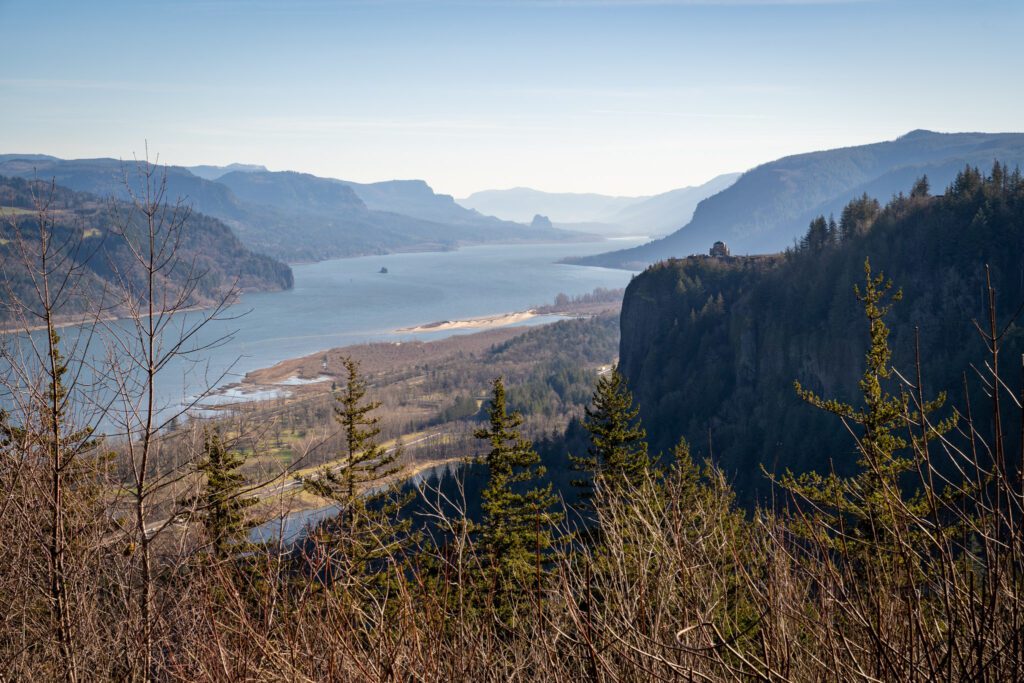
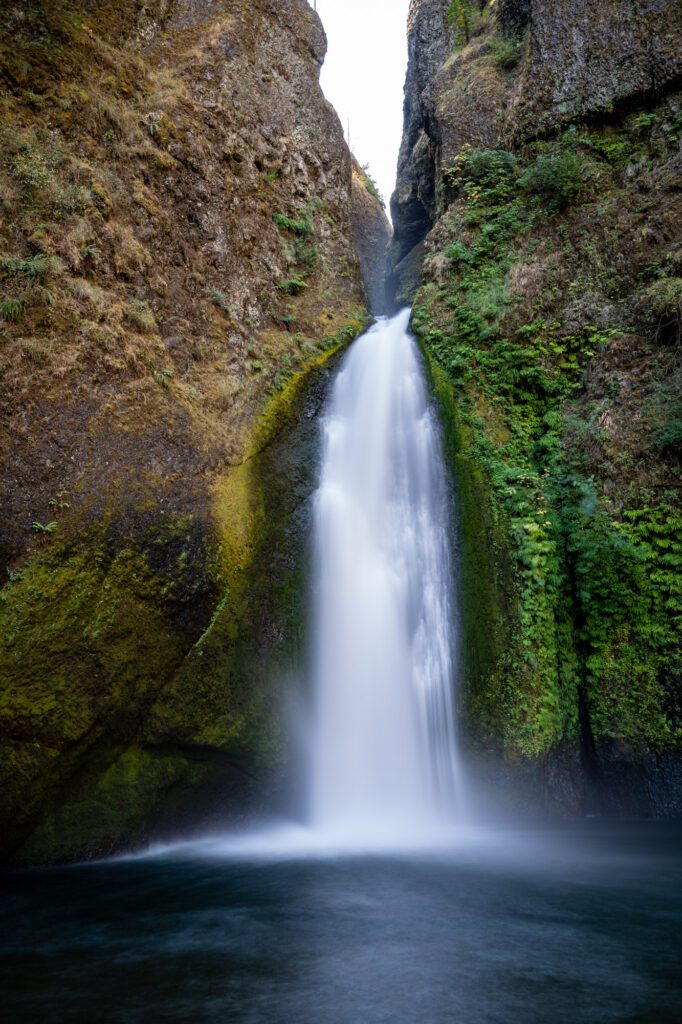
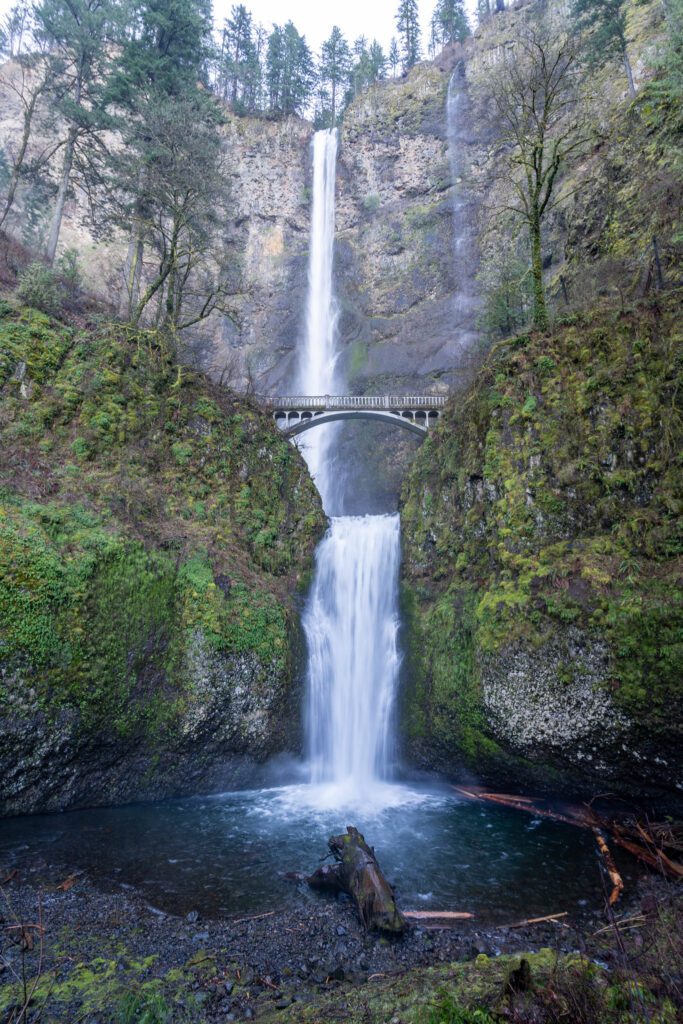
Day 14: Explore Portland
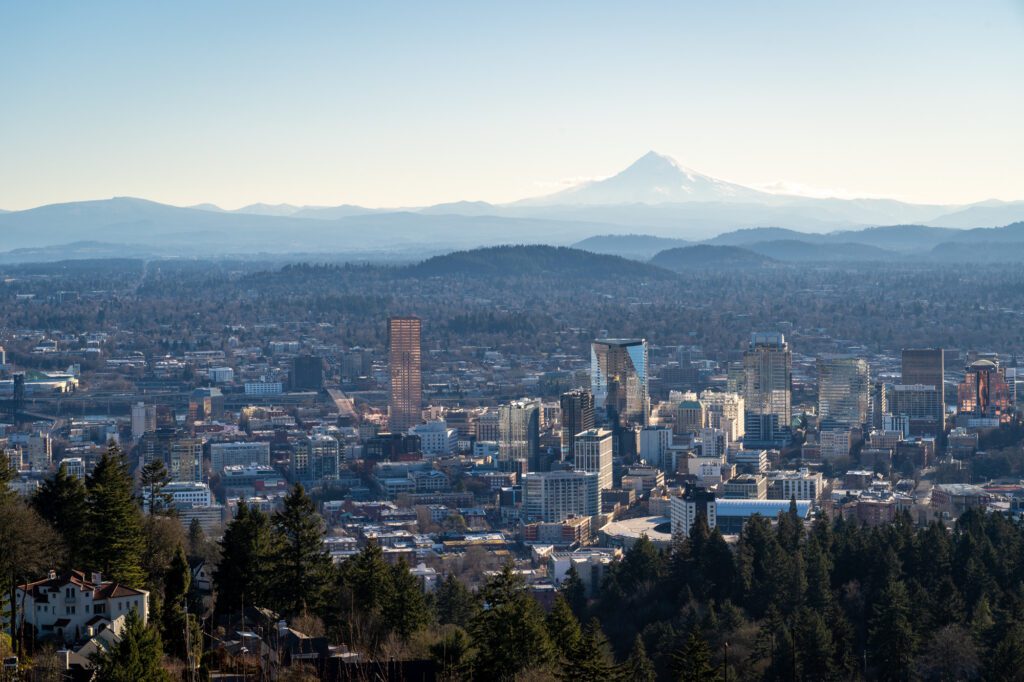
Drive Time / Distance from Hood River to Portland: 1 hour / 63 miles
Where to Stay in Portland: Portland is – by far – the biggest city in this guide, so we’d recommend reading our in-depth guide to choosing a place to stay in Portland for the information you need to make the best choice for you (which takes more than a couple of sentences).
What can we say about Portland? We have fallen head-over-heels in love with our new home. Everyone always talks about the “weirdness,” which we have come to understand as an implicit permission to be whoever you want to be.
That idea flows through to the unique small business culture that exists in Portland, where you can find all sorts of locally made foods, crafts, and home goods.
The funny part about Portland is that there aren’t really any big name tourist attractions. Seattle has the Space Needle, San Francisco has the Golden Gate Bridge, and Portland has… a donut shop and an independent bookstore? But, honestly, that’s kind of why we love it. It’s not that there isn’t a lot to do – there’s plenty of amazing things to do in Portland.
The food scene? The best on the west coast (except for maybe L.A.). There’s a culture of innovation – which we think is at least partially driven by the food cart scene that allows for low-cost experimentation (versus opening a brick and mortar location).
The access to the outdoors? Between the excellent parks in Portland and the access to the mountains, Gorge, and coast, it’s hard to beat.
We’re in love with our home, and think you’ll like it too.
Unfortunately for you, your time here is limited, and we’ve intentionally chosen to weight this road trip towards Oregon’s natural beauty, which means you’re left with about a day, maybe a day and a half to explore the biggest city in the state.
If you have an extra day or two, it’s absolutely worth adding time here.
What to Do in Portland
Now, there are way too many things to list here, so we’re going to focus on our top five here.
Powell’s City of Books: The fact that we’re starting with an independent bookstore – the largest in the world, no less – tells you just about everything you need to know about Portland. It’s right in the heart of downtown Portland, and is an astounding collection of books from all genres. This place is amazing, and even since we’ve lived here I can’t walk out of here with at least one book. I bought a light blue Powell’s Books t-shirt on clearance almost a decade ago that I wear often, and every time I wear it outside of Portland (usually in Seattle) at least one person stops me to chat about how much they love Powell’s. They have an extensive collection of books, including big sections dedicated to fantasy/sci-fi, Pacific Northwest history, and graphic novels. We especially like the staff picks section in the entryway, which is a nice way to see what the staff are reading and recommending at the moment.
The International Rose Test Garden: Washington Park – which is the park where this rose garden is located – is the best park in Portland, and is home to a bunch of different attractions including the Oregon Zoo and the Portland Japanese Garden. But the Rose Garden, which is both free and spectacular, is the best of the bunch, we think. There are 10,000 roses here, and when they’re in full bloom between roughly May and September (sometimes longer), it’s quite a sight to behold.
Breakfast / Brunch in Portland: Portland is an excellent food city in general, especially when you consider prices are going to be about 25% lower than other cities on the west coast. However, it really shines in the morning, when you’ll find some world-class breakfast and brunch options.
Now, you might expect to see Voodoo Donuts on this list.
The novelty donuts are fun, yes, but it’s far from undiscovered, and there are honestly much better doughnuts to be had in Portland. Like, a lot of them. Go to Blue Star, Doe Donuts, Coco Donuts, or Petunia’s Pies and Pastries (for gluten free and vegan donuts) if you’re in and around Downtown Portland.
Here are some of our favorites, in no particular order.
- Fried Egg I’m in Love: Award-winning breakfast sandwiches! They have a food cart in downtown Portland, along with a brick & mortar shop on Hawthorne Blvd in Southeast Portland and up on Mississippi Avenue.
- Ken’s Bakery: The best bakery in Portland, probably. It’s in northwest Portland, and is a local favorite with a rotating selection of pastries that you can see them making right behind the register. Good sandwiches for lunch, too, but the hero is the pastries in the morning.
- Pip’s Original Doughnuts & Chai: Go for the mini donuts (they are NOT donut holes, Matt!) with innovative flavors, stay for the incredible chai. There’s a perpetual line, especially on weekends, so go when they open if you can. Alysha LOVES their chai (get a chai flight!).
Explore The Eastside: While most of the tourist attractions like Powell’s and the Rose Garden (though Powell’s has a location on Hawthorne) are on the west side of the river, we actually like the east side of the river more. We’d divide this large and sprawling area into three distinct areas. If you’re staying downtown and don’t have a car, your best bets are going to be:
- The Central Eastside: Just over the river from downtown, this area is an old industrial district that has become a great place to spend an afternoon, with all sorts of places to eat and drink. We like Schilling Cider House (for 50 taps of different ciders), Cascade Barrel House (for beer), and the Revolution Hall Rooftop for drinks with panoramic views of Portland and Mount Hood).
- Southeast Portland: Our neighborhood! Centered on Hawthorne Blvd and Division St, this stretch runs straight through a residential neighborhood and is full of places to eat and drink. Fried Egg I’m in Love (breakfast sandwiches), Cibo (pizza), Lauretta Jean’s (pies), Pinolo Gelato (gelato), Magna Kusina (Filipino), and Oma’s Hideaway (Malaysian / Singaporean food) are the spots we’d hit.
- Mississippi Avenue: Where we used to live! The stretch along Mississippi Avenue might be the most bang-for-your-buck in terms of the amount of bars and restaurants packed into a relatively short stretch. For food, Lovely’s Fifty-Fifty (of Chef’s Table fame), Kate’s Ice Cream (plant-based ice cream), and the food cart pod at Prost. For drinks, go to Interurban. For shopping, don’t miss the Meadow, a store that we go to far too often with salt, chocolate, and bitters.
- The Alberta Arts District: The furthest from downtown Portland, Alberta Street is one of the main corridors in northeast Portland. Similar to the other places on this list, it’s packed with great food, drinks, and coffee. For coffee, don’t miss Proud Mary (our top coffee shop in Portland for fun single-origin coffees) and Barista. For food, go to Tin Shed Cafe for brunch, Zilla Sake for excellent sushi and sake, and Matt’s BBQ Tacos for…tacos. For drinks, Bye and Bye for good drinks and vegan food, and Great Notion Brewing for beer (and the aforementioned Matt’s BBQ Tacos, which operates on their patio).
For more, we’d encourage you to head over and read our other Portland guides.
What to Add with More Time in Oregon
Like we’ve said time and time again, two weeks is not really enough time to see everything there is to see in Oregon. Here are a few more things to consider adding if you happen to have more time.
More Time in Portland (+1-2 Days)
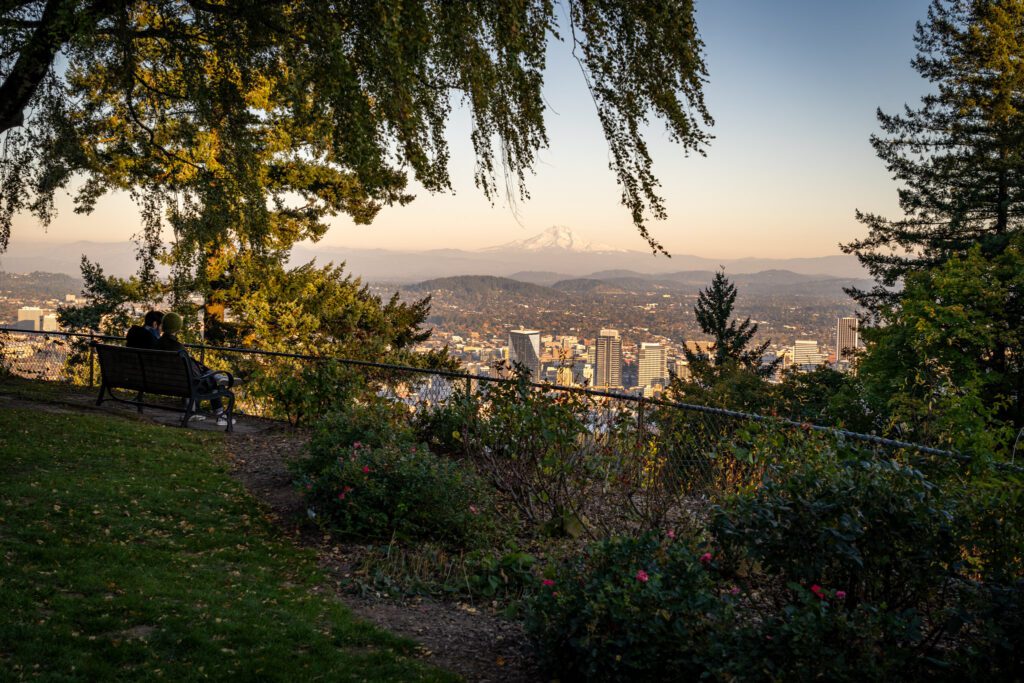
As we mentioned above, we intentionally decided to weight this itinerary towards Oregon’s natural beauty and have you spend the vast, vast majority of your time outside of cities.
Which, unfortunately, leaves you with just over a day to explore Portland.
Ideally, you’d spend two or three days in Portland, which is one of the most underrated food cities (quickly transitioning to “appropriately rated”) cities in the country.
There’s a strong culture of experimentation and innovation in Portland’s food and drink scene that puts it on the leading edge of food trends that make it a great place for people who love to eat to explore.
With an extra day or two, you can experience the things that we love about Portland at a more comfortable pace – the amazing green spaces inside the city, and the thriving food and drink scene to name a couple.
If you have the extra time, we have guides to 2 days in Portland and 3 days in Portland (which includes a half day trip to the Gorge, which you could replace with the trip to Silver Falls just below this) which will give you a play-by-play of exactly how we’d spend your time.
Day Trip to Silver Falls State Park (+1 Day)
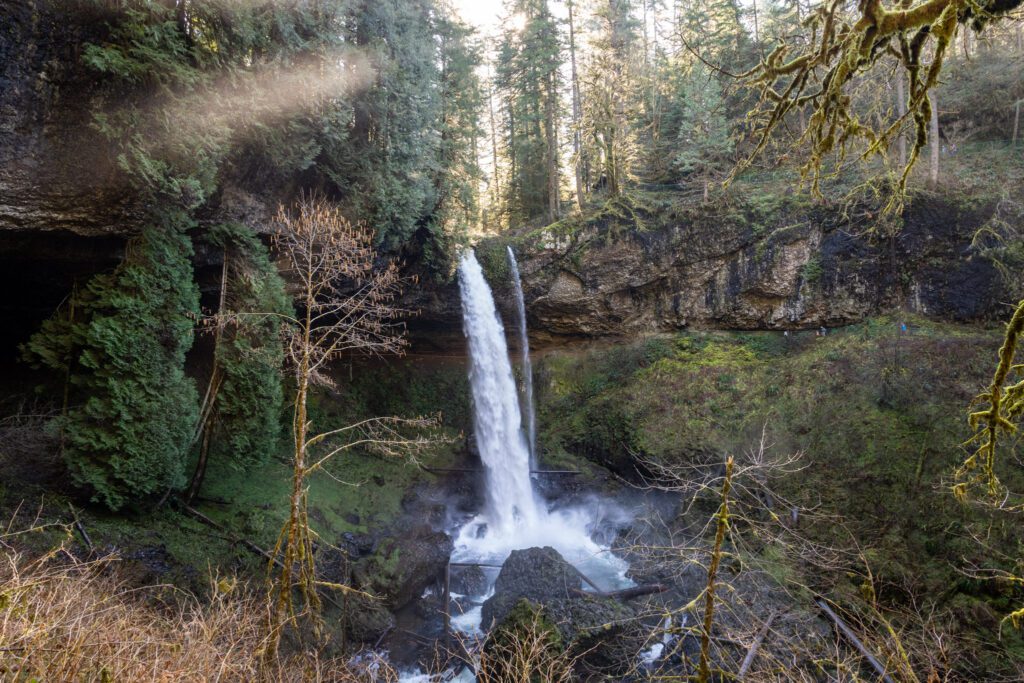
Silver Falls State Park is a hair over an hour south of Portland, and it’s home to one of our favorite hikes in the state – the incredible Trail of Ten Falls. Which, as you might imagine, features 10 waterfalls over the course of a relatively easy eight mile trail.
If you want waterfalls – and especially if you’re here in the spring and early summer when the water is high – this is as close to a must-do as it gets.
After your hike, you can meander through the eastern end of the Willamette Valley on your way back to Portland, stopping at Bauman’s and E.Z. Orchards for farms and cider (and apple cider donuts!).
The tiny town of Silverton is a nice place to stop for lunch after the hike (or just wait until you get back to Portland and check off some other places there!).
If you do want to stay overnight, the campground at Silver Falls is really nice. However, other than that, there’s really not a whole lot of places to stay nearby, and you’re probably better off making it a day trip and staying in Portland for another night.
Crater Lake National Park (+1-3 Days)
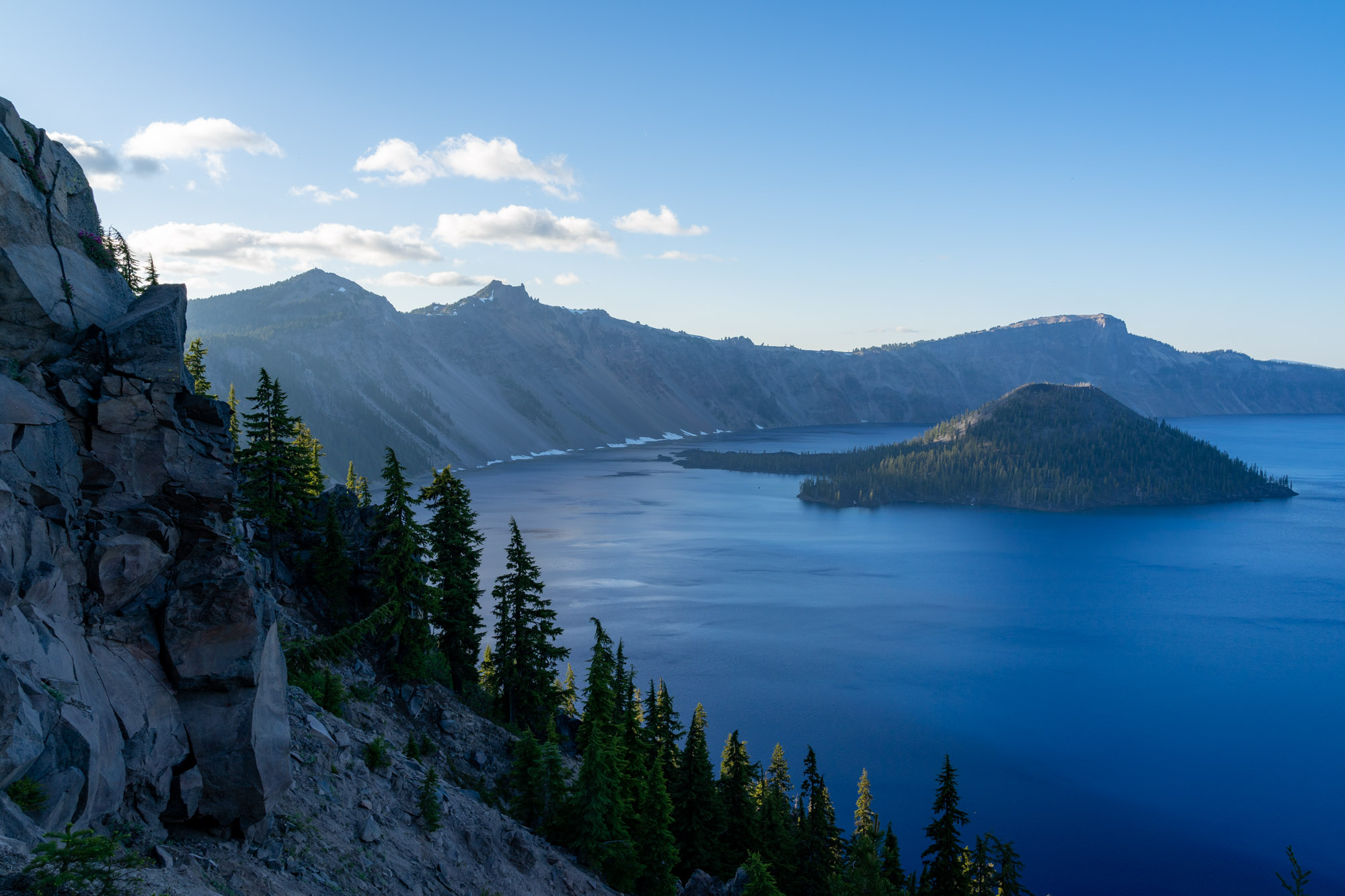
So you want to add Crater Lake National Park to your Oregon trip?
Well, we have good news and bad news.
The good news is that it’s totally doable as long as you have a little extra time.
The bad news is that it’s only really accessible for a few short months a year, and it’s not really convenient even when it’s at its most accessible. It’s at the southern edge of the state, and it’s fairly far from just about everything else on this itinerary.
To add Crater Lake to the itinerary, you’re going to want to do it after Bend. It’s about 90 minutes from Bend to the north rim of Crater Lake, which doesn’t seem so bad, right?
However, there is one major caveat here, and that’s the fact that the rim road that circles around to the north end of the rim is closed during the winter and early spring due to snow.
It will start to open in early spring, but when exactly that happens totally depends on the year.
That’s an issue to keep in mind because Bend is north of Crater Lake. The only way to access the small slice of the park that’s open between November and April (roughly), which is on the south rim, is to enter the park through the south entrance. Which is about three hours from Bend.
We would only really recommend adding Crater Lake during the summer and early fall (call it June through October) when roads will be mostly open, and hiking trails will be mostly snow-free.
Add it as an overnight trip from Bend, and continue along on the McKenzie River Scenic Byway as written.
What to Do with Less Time in Oregon
With less time – 7 or 10 days in Oregon – we’d make some adjustments and be more focused with your time. With 5 days in Oregon, we’d go ahead and spend the entire time in Portland, doing day trips out to the Gorge, the Coast, and Silver Falls to fill your time (you’d want to rent a car for that trip).
With 7 days, we think you have time for a nice little loop that encompasses Portland and the mountains OR the coast, but probably not both.
If you absolutely have to see both, you could add a day on to do a day trip out to the coast (Cannon Beach or Astoria) or the Columbia River Gorge (Hood River).
With 10 days, you have enough time to comfortably do a figure-8 that includes the mountains (Hood River and Mount Hood) and the coast (Cannon Beach and Astoria).
Here’s a day-by-day breakdown of what those itineraries might look like.
7 Days in Oregon: The Mountains
Here’s what a perfect 7 days in Oregon might look like, focused on the northwest corner of the state around Portland.
Add a day if you want to do a day trip out to the coast (and read our guide to the best day trips from Portland).
- Day 1: Arrive in Portland, drive to Hood River
- Day 2: The Columbia River Gorge
- Day 3: Hood River & Around
- Day 4: Mount Hood
- Day 5: Mount Hood
- Day 6: Portland
- Day 7: Portland & Fly Home
7 Days in Oregon: The Coast
Here’s what a perfect 7 days in Oregon might look like, focused on the northwest corner of the state around Portland.
Add a day if you want to do a day trip out to the mountains, and focus on Hood River or Mount Hood.
- Day 1: Arrive in Portland, drive to Astoria
- Day 2: Astoria
- Day 3: Cannon Beach & Around
- Day 4: Tillamook & Three Capes Scenic Loop
- Day 5: Drive to Portland
- Day 6: Portland
- Day 7: Portland & Fly Home
10 Days in Oregon
With 10 days, do a loop starting and ending in Portland that takes you first out to the mountains (and the Gorge), then head west out to the coast for a couple of nights before returning to Portland.
- Day 1: Arrive in Portland, drive to Hood River
- Day 2: The Columbia River Gorge
- Day 3: Hood River & Around
- Day 4: Mount Hood
- Day 5: Mount Hood
- Day 6: Drive to Cannon Beach
- Day 7: Cannon Beach & Around
- Day 8: Tillamook & Three Capes Scenic Loop
- Day 9: Drive to Portland
- Day 10: Portland & Fly Home

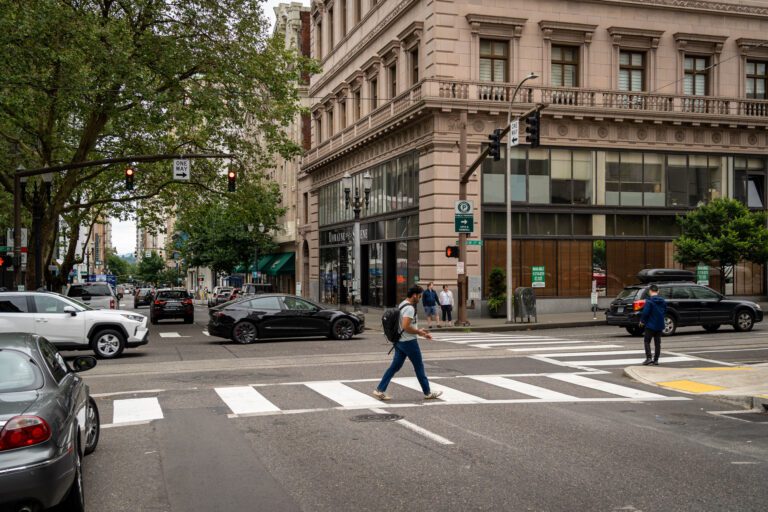
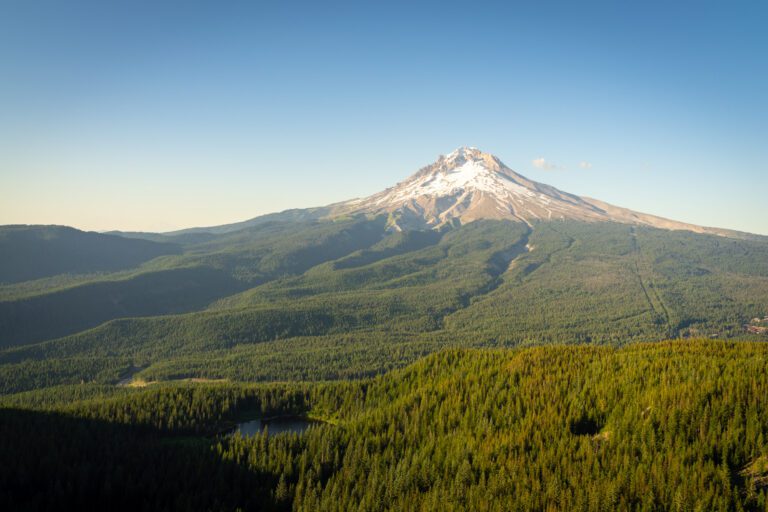
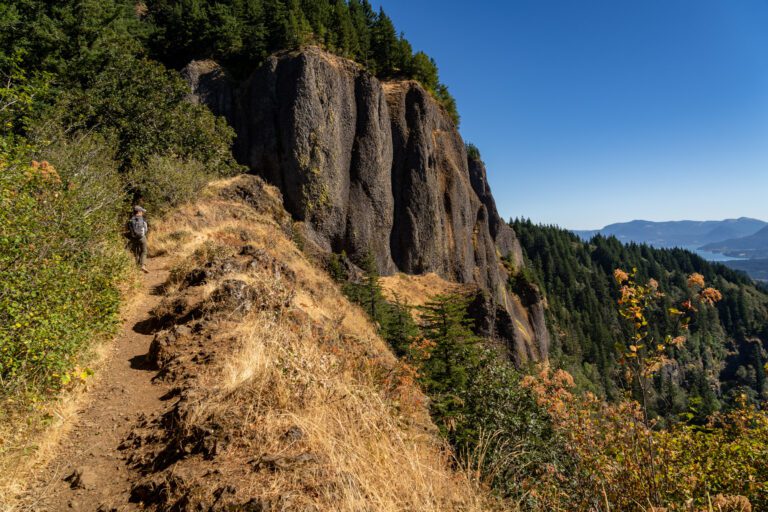
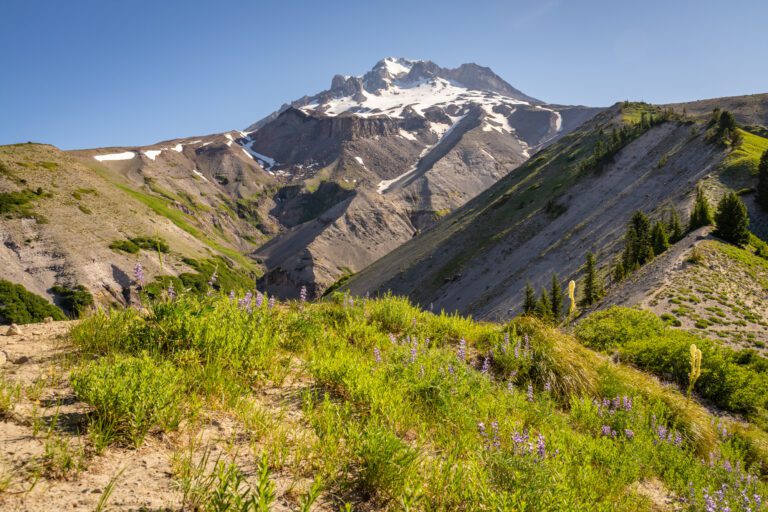

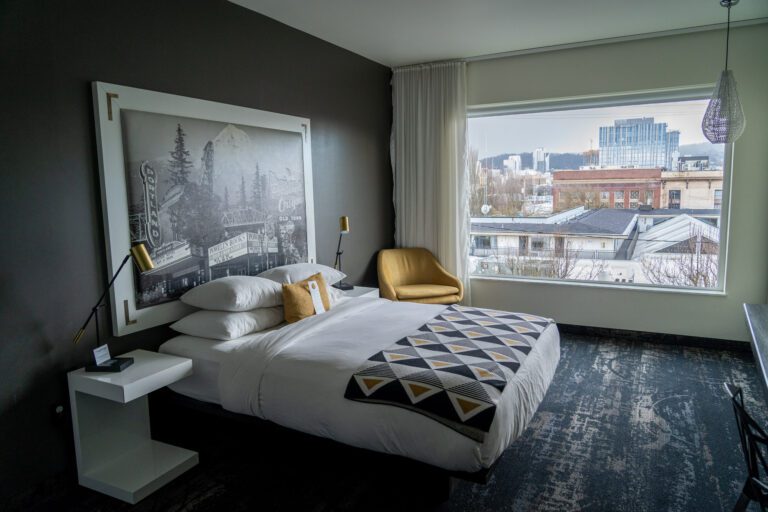
Omg.. I cannot tell you how well written and amazing guide this is.
Everything is broken down so well and easy to understand. Loved your blog and have already fallen in love with all the pictures of the falls and mountains you have on this blog.
Thank you for writing this up..
Will surely use this guide when we plan to travel.
Thanks for the kind words, Kina!